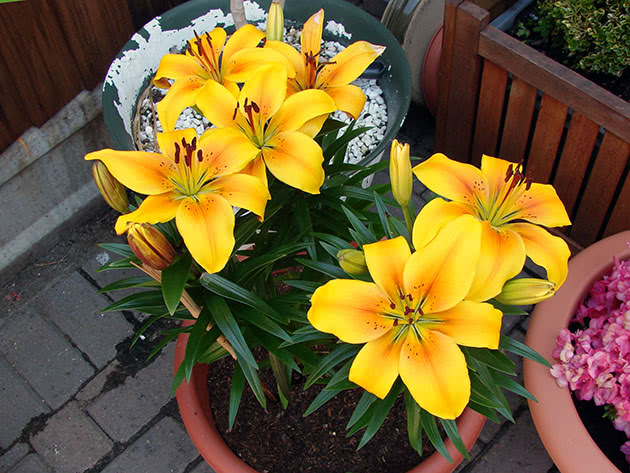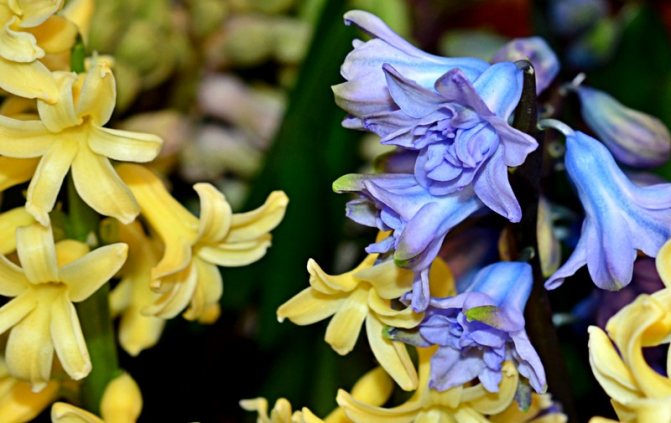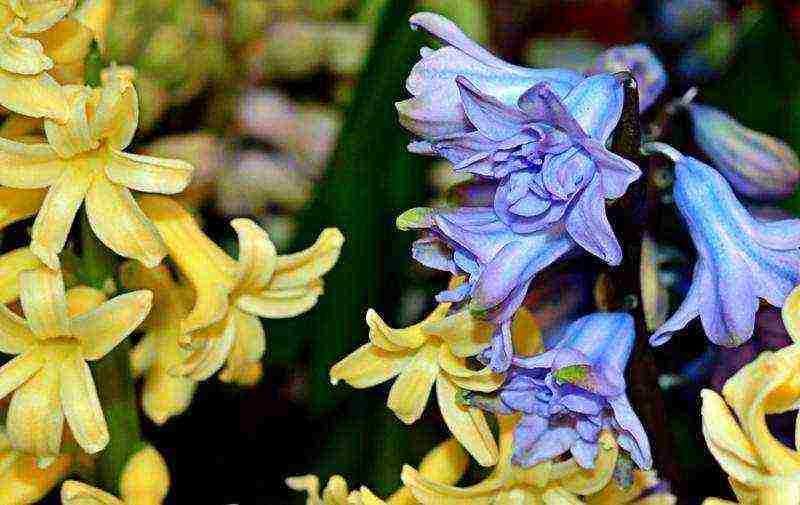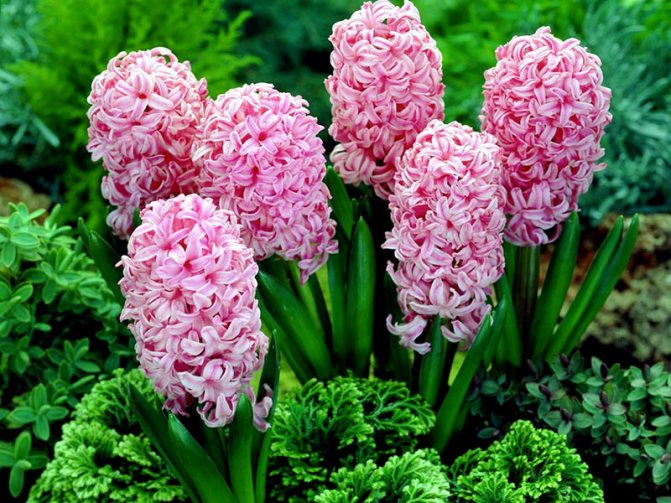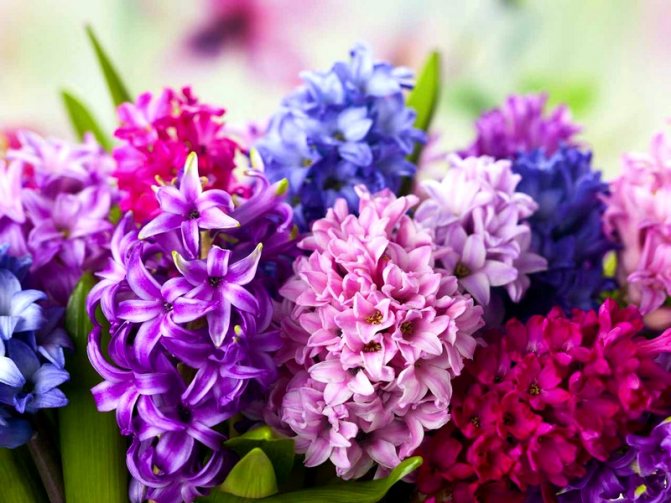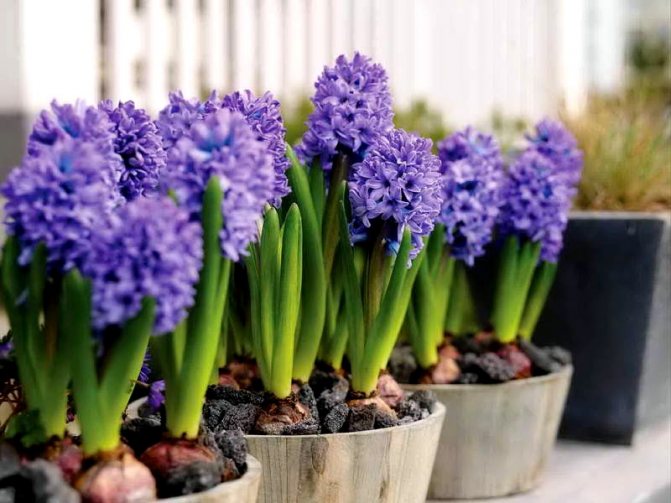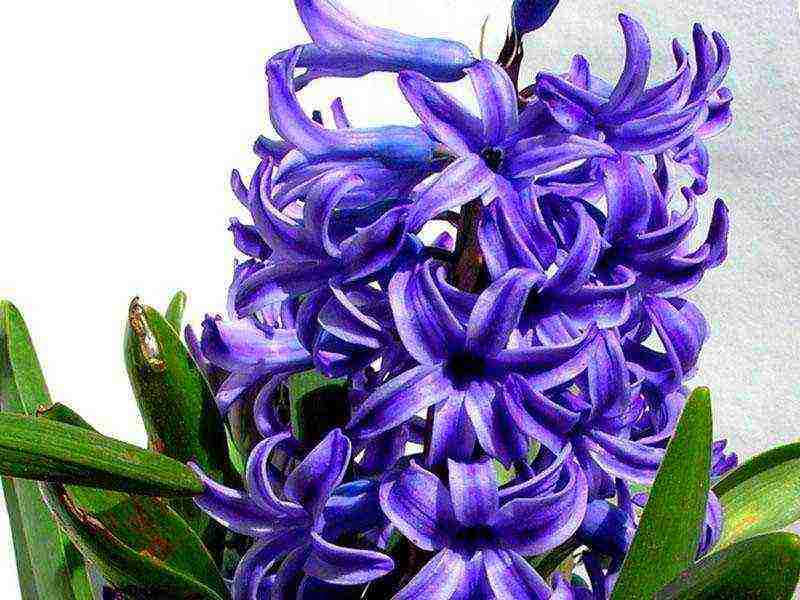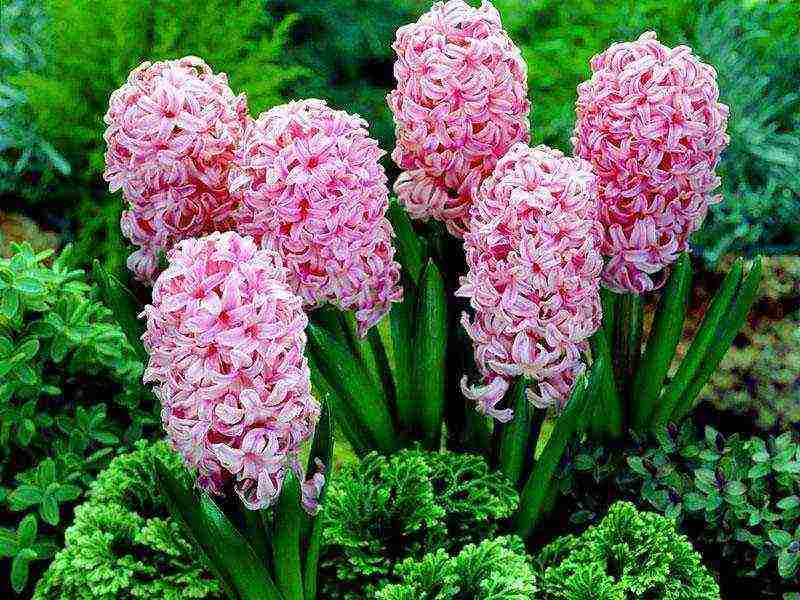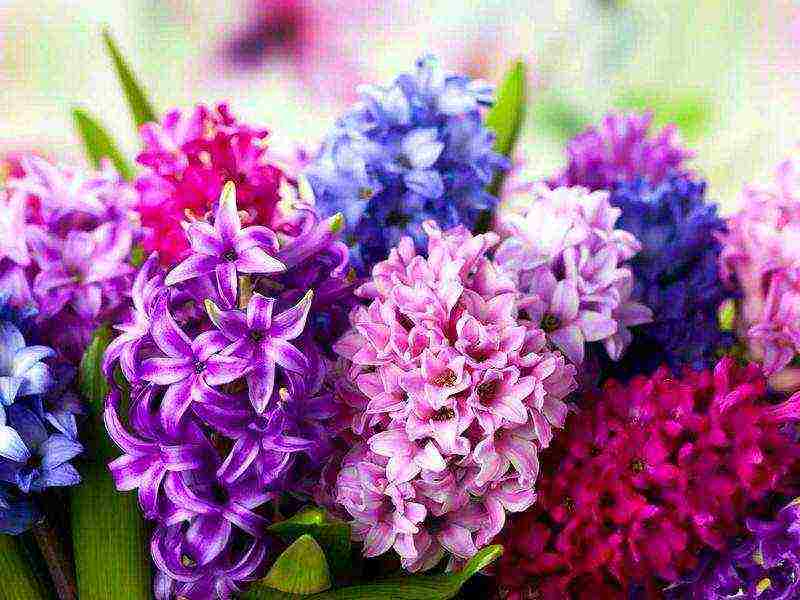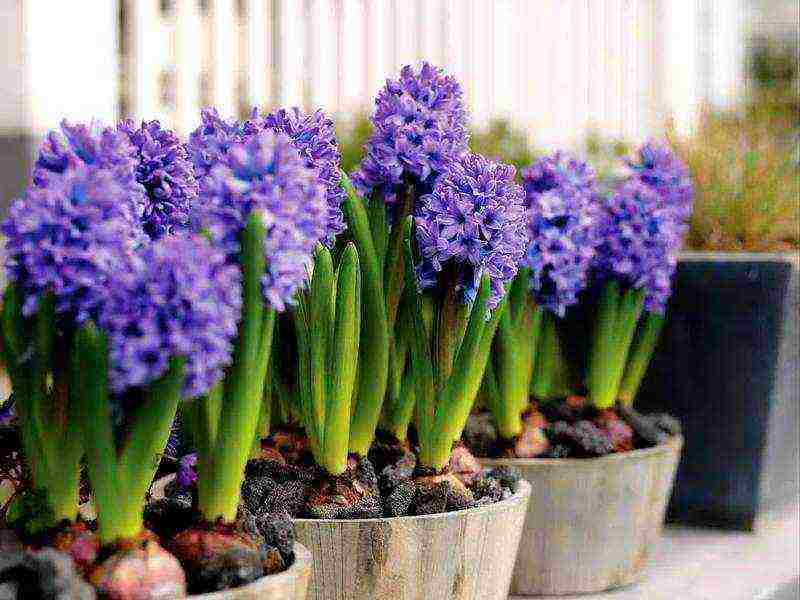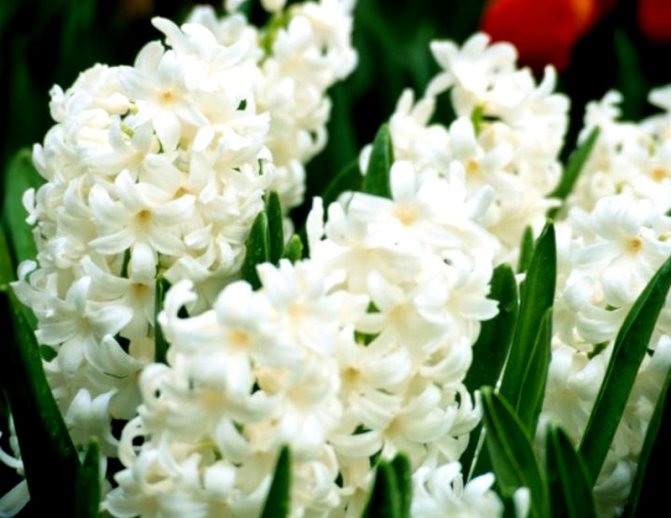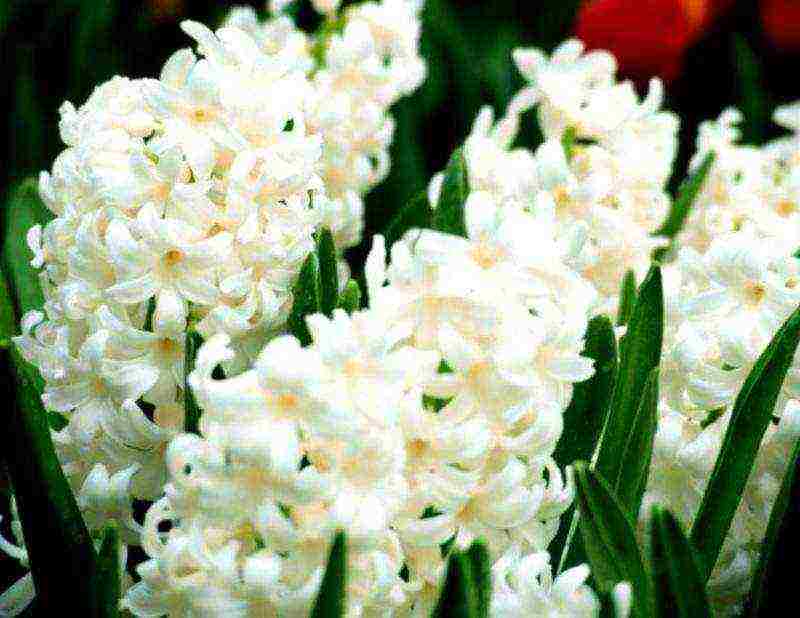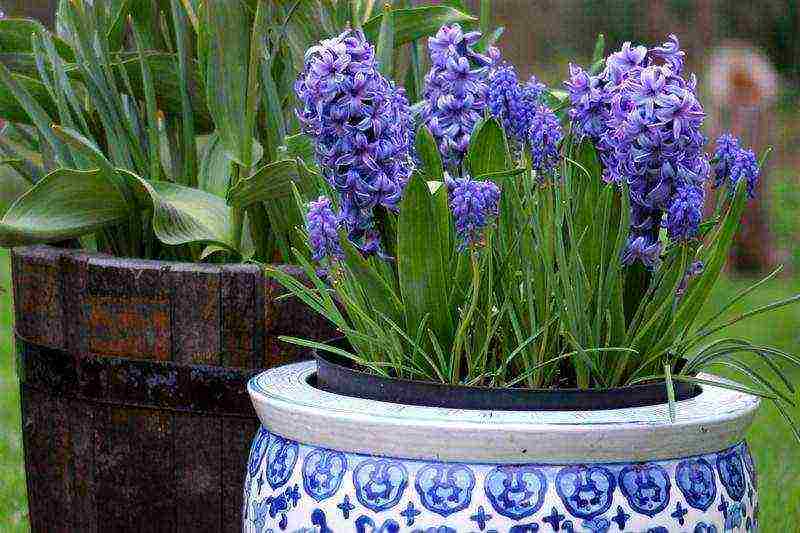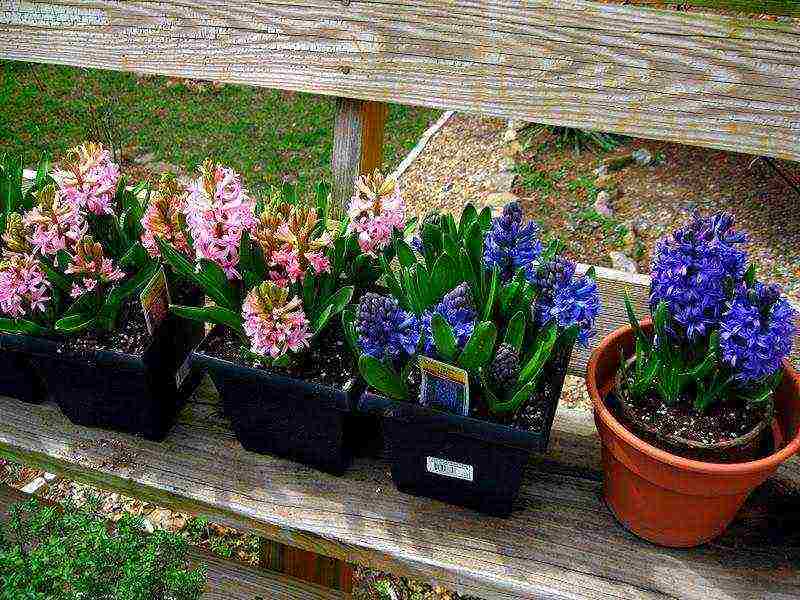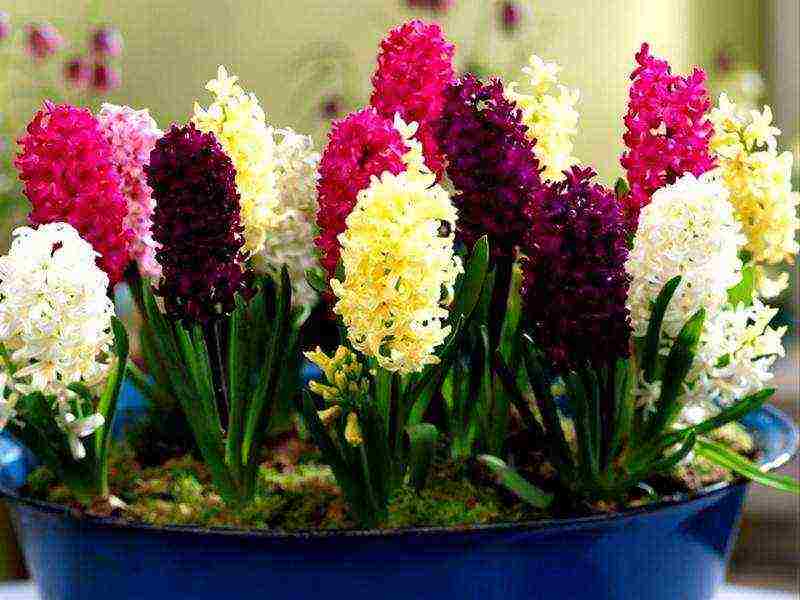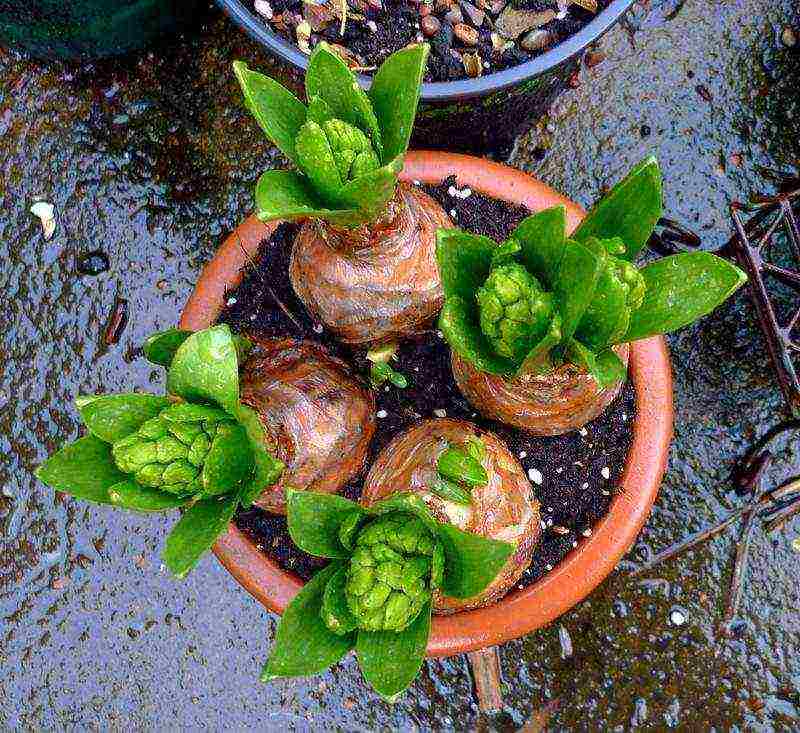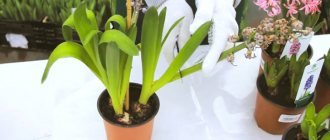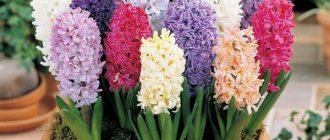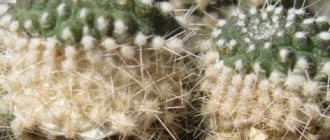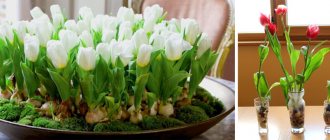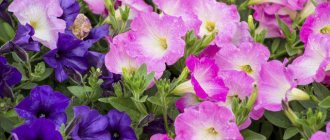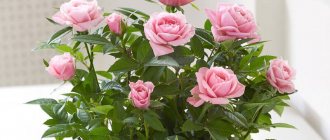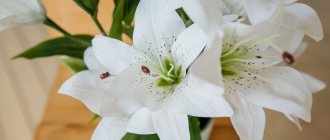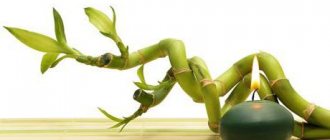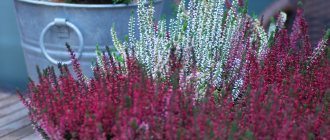Plants of the Asparagus family, namely hyacinths, are the favorite flowers of the fairer sex, which are distinguished by their delicate aroma and beauty. They can please with their flowering at the beginning of spring. Therefore, forcing hyacinths by March 8 at home is a hot topic among flower growers and simply lovers of beauty. They are interested in all the points that relate to the selection of bulbs, planting dates, the intricacies of cultivation and care. The video in the article and expert advice will help you achieve your desired goal.
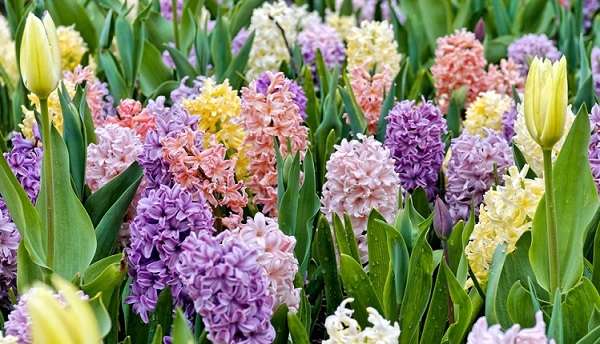
We offer you to learn about how to grow hyacinths at home
Bulb species suitable for forcing
The technology for forcing bulbous plants is not at all complicated. And if you learn its rules, then you can decorate your house with spring flowers all winter. Bulbous plants with a short period from the moment of awakening to flowering are most often grown in the middle of winter. Such plants include: - (cyclamen-like, calcium-loving, triandus, bulbodium); -; - some varieties; - some types of tulips from different (tulips of Kaufman, Greig); - all types of small-bulbous plants blooming in the open field in early spring (crocuses, muscari, scilla, chionodox, pushkinia, iridodictiums, etc.).
But first you need to determine which tulip bulbs and which ones are not. To grow tulips at home in winter, you need Extra parsing bulbs with a diameter of 12/12 + (which means 40 mm or more in a circle), as well as the first or second parsing (from 30 to 40 mm in a circle). The larger the bulb, the larger the flower will be. But her size isn't everything.
The weight of the bulb is also important for the successful forcing of tulips (a heavier bulb is a sign that a flower bud is already in place). It happens that small bulbs are heavier than large ones, which are simply overfed with nitrogen. Tulip bulbs weighing less than 25 g are not suitable for forcing.
In terms of flowering time, forcing is: - early (tulip forcing for the New Year and before Orthodox Christmas); - medium (flowering lasts throughout January); - late (flowering from February to March, and sometimes to April).
To grow blooming tulips in your home by a specific date, you need to know when to start forcing. Early forcing of tulip bulbs requires planting in late summer or early fall. Forcing tulips on March 8, like the average forcing, requires planting the bulbs during October-November.
Tulip varieties are suitable for early distillation: Epricot Beauty, Brilliant Star, Dixis Favorite, Chris, etc. Tulip varieties are suitable for medium distillation: Scarborough, Confux, Apeldoorn, Oxford, etc. For late distillation and dedicated to Women's Day, tulip varieties are suitable: "Parade", "Diplomat", "Vivex", "London", "Keys Nelis", "Eric Hofsier", etc.
Forcing tulips by 8 March requires planting the tulips in late October or early November. Before planting, remove the covering scales from the tulip bulb to inspect for disease and speed up rooting. Treat the bulbs with a bright pink potassium permanganate disinfectant solution.
The optimal substrate for forcing tulips is a mixture of 1 part river sand, 1 part or rotted manure and 2 parts of garden soil with the addition of a certain amount. Fill the container with this substrate two-thirds of its volume and compact it slightly, then spread the tulip bulbs on the surface at a distance of 1 cm from each other and lightly press their bottoms into the soil. Fill the container to the top with the same substrate or clean sand and pour abundantly with a 2% solution of calcium nitrate.If the soil settles from the liquid and the tops of the bulbs are exposed, then add more sand or substrate on top so that there is a small layer of soil (1-2 cm) above the bulbs. Then place the container with the bulbs in a dark place with a temperature of 5-9 degrees with an air humidity of about 75 percent. Do not let the substrate dry out - water it as needed. As soon as the sprouts appear, the temperature of the content should be reduced to 2 degrees.
About three weeks before the intended flowering date, bring the container into a room with twilight and a temperature of about 13 degrees. After 4 days, place the sprouted bulbs in a bright room with a temperature of 16-18 degrees. Now it's time to use additional lighting to increase the daylight hours for growing tulips up to the required 10 hours. If the day is shorter, the tulips will start to stretch out painfully. When the buds acquire the color characteristic of the variety, the temperature must be lowered by a couple of degrees - this will make the flowering longer and brighter. Caring for flowering tulips consists in regular watering of plants and periodic feeding with calcium nitrate.
Bulk forcing of tulips in the greenhouse is practiced mainly to obtain a large number of flowers for sale.
In the photo: forcing tulips in pots; forcing hyacinths in water
Types of modern hyacinths
Modern hyacinths are classified into six varieties, which differ from each other in their color. It is necessary for both an experienced and a novice florist to know them, so as not to become a victim of deception and not to acquire plant seeds with red flowers instead of yellow.
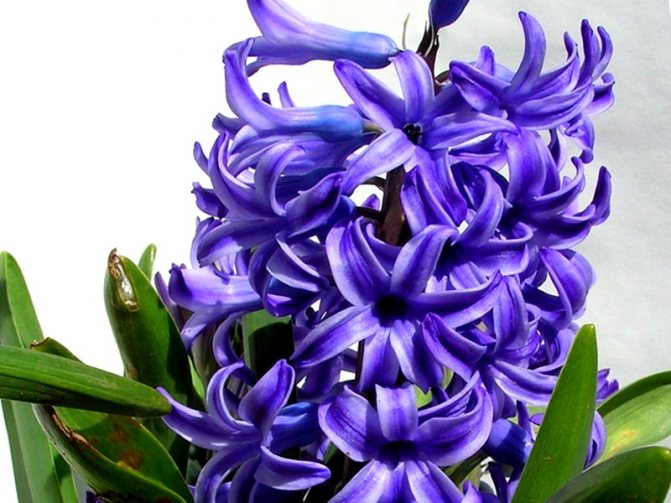

So, the first group of hyacinths includes plants that have flowers with a blue color. These include the following varieties:
Forcing hyacinths in a pot and in water
On the site on the site on the site on the site on the site
Weekly Free Site Digest Site
Every week, for 10 years, for our 100,000 subscribers, an excellent selection of relevant materials about flowers and garden, as well as other useful information.
Subscribe and receive!
It is an indisputable fact that the degree of a rainbow festive mood helps to raise a bouquet of magnificent tulips. Unfortunately, it can be easy to make a mistake and buy flowers that are not the first freshness. But there is a way to not trivially solve this problem. Flawless buds of excellent quality can be obtained using forcing tulips. How not to miss the timing of distillation, the correct technology, direct planting and further care at home, we will tell in this article.
Reasons why distillation may not work
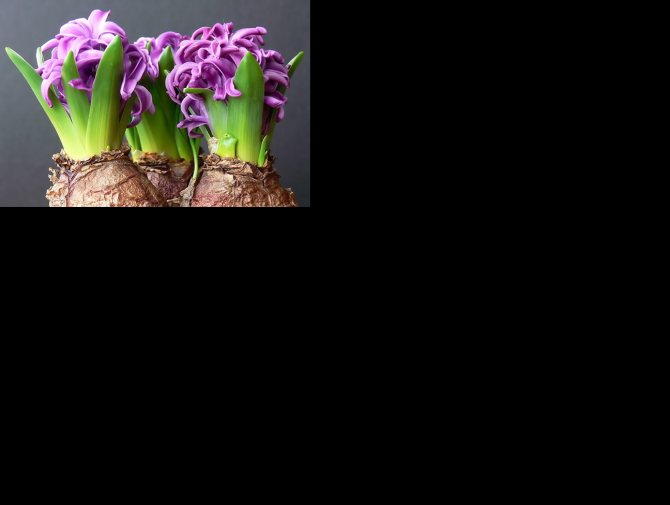

This can happen for several reasons:
- The leaves have withered - excessive watering.
- Short peduncle - Bulb has not gone through full dormancy at low temperatures.
- The peduncle has not grown - a flower bud is formed only during high temperatures. Another reason is that the bulb is small and weak.
- Leaves turn yellow - this is due to a lack of light or a draft.
- Falling buds are the reason for irregular watering.
Try to take these recommendations into account and follow the step-by-step instructions, and then forcing hyacinths at home will not create problems for you.
When to plant tulip bulbs for distillation
By the way!
Except for March 8, tulips are planted for distillation for the sake of other spring holidays, for example, for Valentine's Day or February 23.
The best time to start planting tulip bulbs for distillation is October-early November. More precise dates are determined depending on the specific holiday for which you are going to grow flowers:
- If by Valentine's Day (February 14), then you need to start planting already in early October.
- By February 23 - from the second decade (from 10) October.
- By March 8 - from the middle to the third decade (from 15-20) October.
Why exactly on these dates? But because of what:
Worth knowing!
All bulbous flowers must pass
rest or cooling period
... The future flowering depends on its duration and quality. at this time, a flower bud is formed in the bulb.
- After planting the tulip pots should spend 90-150 days in the cold, i.e. about 3-5 months (depending on the variety);
- then 20-30 days in a warm place - before flowering (depending on the variety).
Note!
Of course, you can try to plant for distillation already
hatched bulbs
tulips
in January or February
but you will hardly be able to get a good flowering, because the bulbs did not have an adequate cooling dormancy period.It's another matter if you purchase already chilled onions.
Selection and preparation of bulbs
Growing hyacinths by March 8 begins with the acquisition and preparation of the bulbs. At the same time, it is worth remembering that this process takes 3-4 months, so preparation for it must be started in the summer. First, you need to purchase the varieties you need for growing. But if you do not know how to grow hyacinth by March 8, it is worth starting to familiarize yourself with this process with plants that have the simplest flowers. The fact is that they are the least capricious and are well driven out.
If you do not buy planting material, but grow your own, the hyacinth bulbs will need to be removed from the soil immediately after the hyacinths have bloomed and shed their leaves. This usually happens in the summer around June or July. It is recommended to purchase the material ready for planting in the fall-spring.
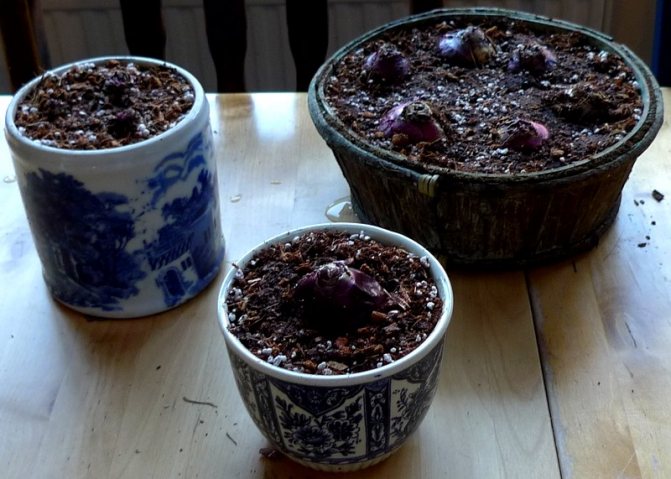

Choose only healthy, dense and large bulbs with a diameter of 5 to 6 centimeters. They should be ripe and weigh about 100 g. However, if you take a good onion in your hands and try to squeeze it with your fingers, you should feel resistance. If dents have formed on the surface of the bulb, it is better not to use it for forcing, as this is the first sign of spoilage. In addition, it is necessary to inspect the bottom - it should not show signs of rot or other signs of damage.
Important! It is also worth noting that if you buy bulbs in the fall, you need to purchase planting material only with a special mark “for distillation”.
The manufacturer kept them alone at a low temperature, and after planting, they can quickly begin to bloom. To preserve these bulbs prior to planting, they will need to be placed in a dry, cool environment at + 17 ° C.
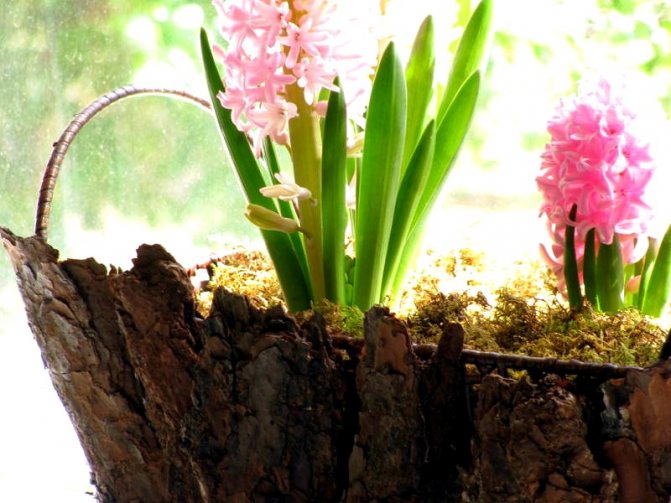

If your bulbs are ordinary and have not undergone special training for distillation, they should be stored in a dry place at + 25-28 ° C. This is necessary for the formation of a new flower bud. After it is formed, around September, the bulbs will need to be placed at a temperature of + 17 ° C in a fabric or paper bag immediately until the very time of planting. By the way, pre-planting material must be dried within 2 days.
There are several ways to drive hyacinths out by March 8th. So, today it can be done as follows:
The most popular way to get hyacinth by March 8 is to cultivate it in a greenhouse. Forcing hyacinths by March 8 in a greenhouse will give you a large number of flowers for a relatively small financial investment. Home cultivation of hyacinths will not give you that amount, therefore, it is not suitable for growing them for sale.
Technology for distilling tulips by March 8 at home
It is very tempting to create a miracle yourself in the form of a charming bouquet of flowers for the long-awaited holiday. However, to do this, several recommendations must be followed regarding the selection of suitable bulbs, the appropriate substrate, planting containers and the preparation of the bulbs for planting.
Selecting bulbs for forcing
For forcing tulips by March 8, you must choose exclusively large and heavy bulbs
(from 25-30 grams, with a diameter of 4-5 cm), in other words,
extra class
... Only such bulbs will be able to please you with powerful spring flowering, because only strong and strong (ie large) planting material can cope with "forcing" in unnatural conditions.
It is worth understanding!
A large bulb is not a 100% guarantee, because many other factors affect the flowering and development of the flower.
In general, it is best to purchase dutch bulbs
which
specially designed for forcing
that should be written on the packaging itself.
Important!
Bulbs must not only be large, but also of perfect quality.
Necessary substrate and planting container
For forcing tulips, a large amount of land is not required, so it is enough to take small pots with drainage holes.
The main thing is that they
height
was
not less than 15-20 cm.
If you are going to grow many flowers at once, then it will suit you
boxes or containers.
By the way!
It is recommended to plant 3-5 bulbs in a pot with a diameter of 12-15 centimeters. In other words, it can be planted tightly, at a distance of 1-2 cm from each other. Moreover, it is advisable to plant bulbs of approximately the same size and variety in each separate container so that they develop more or less in the same way.
For forcing tulips, it is advisable to use quality soil
, which the
good moisture and air permeability
, which means it should be
loose
... Thus, you can prepare the nutrient substrate yourself by taking in almost equal proportions
garden land
(a little more), excellent
humus
(smaller) and river
sand.
Note!
If you want to use garden soil, then shortly before planting it must be
steam in the oven
and / or
shedpink solution of potassium permanganate, or even better,
to disinfect and prevent the occurrence of possible diseases.Better yet, put pills in the ground for extra protection "Glyokladina"
from decay.
Or you can just mix purchased land for flowers
(but peat based)
with river sand
(2 to 1).
Advice!
Instead of sand, if desired and as possible, you can use
vermiculite
.
In principle, bulbs can be planted for forcing in sawdust or sand
... But it should be understood that there is no nutrition in such soil, which means that after forcing such bulbs can simply be thrown out, but not saved in any way.
It will be very good if you add to the substrate calcium nitrate or nitroammophos
(1 teaspoon for a small pot).
Preparing the bulbs for planting
Before planting bulbs in pots, they must be properly processed, namely:
- Remove scales.
Important!
It is not necessary to remove the scales during planting. But under them can be hidden spots of fungal diseases, therefore, in order not to plant diseased bulbs for distillation, they are undressed and examined. The peeled skin will also help the bulb to take root faster.
Direct landing
Step-by-step instructions for planting tulip bulbs for distillation at home for the winter and spring holidays (for Valentine's Day, February 23 or March 8):
- Decide on the timing of planting the bulbs, depending on which holiday you want to get flowering bulbs.
- Purchase suitable planting material (large bulbs).
- Prepare the container, substrate and the bulbs themselves for planting.
- Fill the planting containers with the substrate.
- Moisten the ground slightly (you can spill it with a disinfectant solution).
- Bury the bulbs in the ground, but not completely, so that the top (top) remains above the ground.
- If desired, to better preserve moisture, you can cover the pot with something on top, for example, a bag or container. Otherwise, you will have to water much more often.
- Remove container to a cool place where temperature + 5-9 degrees, and humidity about 70%
(these are optimal conditions for rooting).
Advice!
At home, it is best to use a refrigerator (bottom shelf) or a glazed loggia (balcony). If you have a basement or cellar, then, of course, it is better to put the bulbs there.
The choice of capacity and substrate
Knowing when to plant homemade hyacinths by March 8, you will be able to grow a whole flower garden by this time. However, first you need to take into account a lot of recommendations. For example, choosing a pot for your bulbs is very important. Its height must be at least 15 cm. The diameter of the container will depend on the number of bulbs. Remember that they should not be in contact with each other or with the walls.
It is recommended to fill the bottom of the pot with a drainage layer: crushed stone and sand. The optimal composition of the soil mixture includes humus, turf soil, and coarse sand. Remember to compact the soil well and also water it. Inspect the bulbs carefully before planting. There should be no rot on them.
Further care of tulips after planting for distillation
Now you need monitor soil moisture in pots
, watering as it dries, i.e. about once a week.
Note!
But the soil should not be soggy, moderate moisture is required!
As soon as bulbs
tulips
hatch
(after 3-5 months), they will have the first
sprouts,
and they
will reach 4-6 centimeters
, can
endure
germination pots
to light (but not in direct sunlight) in a relatively warm room (at least + 15-18 degrees)
, for example, into a room on a windowsill.
At the beginning of the growth period for
more
active recruitmentgreen mass
tulips
You can also tryfeed with nitrogen fertilizers
(for example, a solution of urea or ammonium nitrate), and
during budding - potassium-calcium (calcium nitrate and potassium sulfate).
However, as a rule, this rarely gives a significant result, because when forcing, the plant basically takes all the nutrients from the "fat" bulb.
Video: feeding tulips during forcing
Important!
If you see that the bulbs are late in distilling the flower stalks, then you need to raise the temperature and, conversely, if they grow too quickly (in a hurry to drive out the bud), then lower it. The same goes for lighting. Either way, you have to
supplement
, i.e. for normal distillation it is necessary
at least 10-12 hour daylight hours.
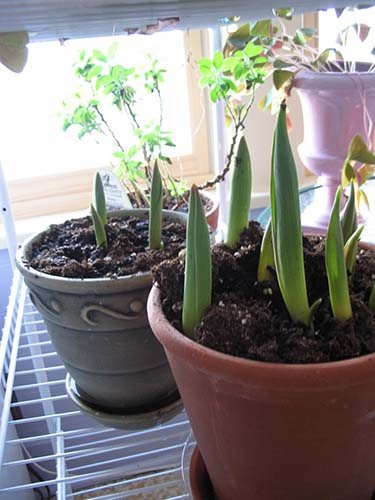

After about 3-4 weeks, the first buds are formed.
And after another week and a half, they will begin to gain color and bloom.
When and how to cut tulips into bouquets after distillation
The optimal cutting time depends largely on the shelf life you expect. Thus, it is necessary to cut tulips after distillation into bouquets at the following stages, depending on the period of their further storage:
- if from 1 to 2 weeks (for sale), then in a state when the buds have not yet been colored (they have just begun to gain color).
- if for 3-4 days (especially for a holiday), then the buds should already be almost completely colored.
After cutting, tulips should be immediately wrapped in paper (newspaper) and stored again in a cold room (cellar or basement) or refrigerator.
By the way! "Give" water to drink
you can both before storage after cutting, and shortly before donating or selling flowers (if you drove them out for sale).
To do this, you must first cut the lower part of the stems, and then put the bouquet in cold water and put it in a cool room for a day.
Video: storage and processing of tulips after cutting
Why tulips planted on a pasture don't bloom
The main reasons why bulbs planted for distillation may not bloom:
- dropped off at the wrong time;
- bought and planted weak planting material;
- used a substandard or unsuitable substrate;
Important!
If you do not disinfect the soil and the bulbs themselves, then they can simply rot during the forcing process.
- did not comply with the conditions of forcing after planting (cooling-rest period and moving to warm and light conditions).
If you used your own tulip bulbs from your garden, and they did not bloom, then the reasons may be as follows, namely, leaving after flowering:
- It was a very humid summer, or you watered too often and abundantly after flowering, when the bulbs gradually retired.
- The leaves were cut too early after flowering (the leaves did not have time to transfer nutrition to the bulbs for it to mature better).
- The bulbs were untimely dug up for storage.
- It was stored incorrectly before disembarkation (the first time after excavation - + 20-23 degrees, a month before disembarkation - + 15-17 degrees).
Further care
When you have planted your bulbs at home, wait until the dormant period is over. After that, the plant will drop the leaves. This will be a signal for you, since during this period it is advisable to place the sprouts in pots on the windowsill. Watch the intensity of the growth of the peduncle. When it reaches a height of about 15 cm, the paper cover can be removed. To speed up the blooming of the buds, it is advisable to increase the daylight hours and the temperature regime. You control these factors yourself.
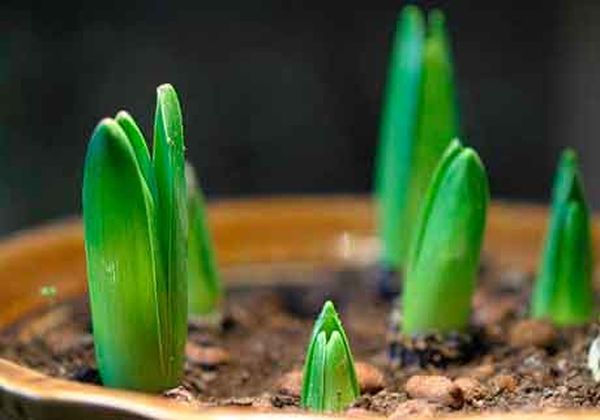

[collapse]
What to do with tulip bulbs after distillation
After the tulips have faded or you cut them into a bouquet, you still have bulbs - what to do with them?
Note!
Bulbs that were left without leaves after forcing (for example, they got rid of them when cutting) are not viable. They just dry up and that's it. Trying to save them is useless.
Forced bulbs tend to look quite emaciated, so there is no point in planting them outdoors in spring.
You can try to put them in storage, but before pickle in fungicide
(for example, "Maxim") or in the old fashioned way in a pink solution of potassium permanganate (for 30-60 minutes). Next, the onion needs
dry and store in a dry, warm place
until September. At the beginning of autumn, plant it in the ground, unless, of course, your onion does not dry out very much (and a tiny replacement onion forms inside).
Important!
After distillation, the bulbs will bloom only after a year, the next year they will not bloom with a 90% probability.
By the way!
And after a couple of years of proper care, if the bulbs grow large and healthy, then you can use them for forcing.
Video: what to do with tulips after distillation
Humanly understandable is the desire to give a loved one a bouquet of fresh tulips for a holiday. One way to do this without disappointing with the quality of the flowers is forcing. However, you need to think over this process to the smallest detail: do not miscalculate with the timing, choose the appropriate planting material, soil, planting container and take into account many other important details, without which it is difficult to expect success.
By the way!
Hyacinths (best of all, even simpler than tulips), crocuses, daffodils and galanthuses (snowdrops) are also suitable for forcing. The technology for growing them at home is almost identical.
You can make bulbous plants bloom in winter using certain technologies. Forcing bulbous plants is the early removal of plants from dormancy under the influence of certain factors, such as temperature, humidity, light. The bulbs "wake up", produce flower stalks and bloom at a time unusual for them.
For full flowering to take place, the bulbs must be properly prepared.
At its core, forcing bulbous is a "deception" of the bulb: by changing the temperature and light regime at an accelerated pace, they simulate autumn, winter and spring, and the plant blooms at the appointed time.
It is important that the bulb must go through all the stages of development laid down by nature. Therefore, it is not enough just to plant a bulb in a pot at the end of autumn, for example, and get a flower by the New Year. The flower stalks are laid in the bulbs during the dormant period.This should be followed by a period of cooling, rooting, awakening and only then the beginning of flowering.
Not all plant varieties are used for forcing. Bulbous plants with a short period from awakening to full bloom are usually chosen. Low-growing tulips, hyacinths, small-flowered daffodils, early spring small-bulbous (crocuses, muscari, galanthus, scylla, chionodox, pushkinia) are suitable for forcing at home.
Each type of plant has its own timing and characteristics of distillation, but there are several general rules that should be followed.
Use a large, healthy onion for forcing
When forcing the flower is obtained mainly due to the reserves of nutrients accumulated in the bulb itself, therefore, only healthy, dense, heavy-weight, with whole scales are selected. From a small onion, a flower will turn out to be small, or even generally underdeveloped. Rotten and damaged bulbs are not used for forcing.
Choose only suitable species and varieties of this plant
Not all types or varieties of bulbous plants can be used for forcing. Therefore, you first need to choose the right varieties. The easiest way is to buy specially prepared forcing bulbs in the store in the fall.
Treat the bulbs before forcing
It is useful to soak the bulbs in a solution of potassium permanganate before forcing or use them as special preparations for disinfecting them from pests.
Observe the technology of forcing for each species
Forcing bulbous plants is a simulation of the seasons at an accelerated rate. Therefore, both "winter" and "spring" must be present during forcing. It is imperative to adhere to the recommended temperature and time parameters.
For forcing tulips, hyacinths and other bulbous plants, bowls, wide low pots, and boxes are used. There should be a drainage hole in the bowls and pots, a thin layer of drainage is poured onto the bottom of the container, then a prepared substrate from equal parts of leaf, turf, humus and sand.
The bulbs are planted in late September, early October so that the tops of those bulbs that are not completely covered are located just below the edge of the pot. Planting depth must be observed for each species according to the instructions. For example, the tops of the bulbs of hyacinths or daffodils are left open 2 cm; in small-bulbous plants, the layer of earth above them is approximately within 1-3 cm.
The bulbs are sometimes planted in separate pots, sometimes they are placed for high decorative plantings close to one another in a wide bowl (small-bulbous with a distance of 1-1.5 cm from each other, hyacinths - 2.5 cm).
How to deal with hyacinth at the end of flowering
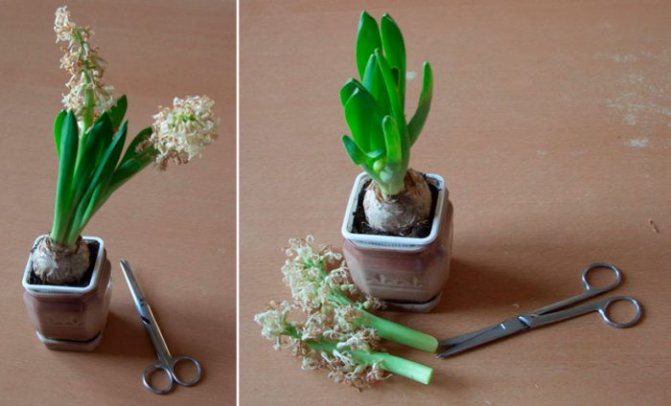

Bulbs that were used for forcing do not bloom the next year. Therefore, they are often simply thrown out. However, they can also be planted in the garden and after a couple of years, these bulbs can be reused for forcing. Remember that there are varieties that do not tolerate winter frosts well. Therefore, it is recommended to sprinkle them with sawdust or dried foliage for the winter.
However, after the hyacinth has faded, it is most often impossible to plant it outside, since winter is still in full swing there.
In the literature, you can find advice that such hyacinths should be stored dry in a flower pot, sawdust or peat chips. In autumn, the flower is transplanted into open ground. However, these bulbs often dry out, as it is very difficult for them to withstand the dry storage time, which begins in February or March and ends in autumn. If they survive, then in the next year such hyacinths will not bloom.
It is best to preserve hyacinth after flowering in room conditions. To do this, he needs to remove the peduncle and provide moderate watering. From a pot that is too small, it is recommended to carefully transfer it into a large one. Use a loose soil, so it is recommended to pour sand into the purchased substrate. Place the pot in a well-lit place.The flower forms fresh leaves, and it will grow like its other garden relatives. Before the onset of summer, it can be transplanted into open ground, while the neck of the bulb does not need to be buried.
These hyacinths may well begin to bloom in the next year. And also they most often form daughter bulbs.
Winter for bulbous plants
The planted bulbs are watered and covered with a thick cloth or black opaque polyethylene with ventilation holes. You can cover with empty pots or put in a box, it is important that it is dark. After that, they are put on rooting in a dark, cool place with a temperature of 4-8 degrees for about 10-12 weeks (for later forcing, it takes 13-14 weeks). This can be a basement, an unheated (but not a freezing veranda), and in the absence of a suitable room, put it in the lower part of the refrigerator, where vegetables and fruits are stored.
During this cold storage, the bulbs develop a root system and sprout. It is not recommended to shorten the cooling period, this can lead to underdevelopment of the peduncles. Sometimes you need to check if the earth is dry, if necessary, moisten it.
Landing rules
Planting hyacinths is necessary according to the step-by-step instructions. To do this, you should follow these recommendations:
- flowers are planted in such a way that a third of the plant remains on the surface;
- sprouts after rooting need to be compacted, and then moisten the substrate;
- the next stage - the plants are covered with a special paper cap and placed in a room with a temperature of + 4 ... + 6 ° C. In such conditions, the planting material will remain for 2-3 months.
Forcing hyacinths by March 8 or New Year is a very real thing. The main thing is to start implementing your plan in time. Then on a holiday you can please your loved ones.
Spring for forcing plants
To "wake up" the bulbs and stimulate flowering, the bowls are opened and transferred for one week to a bright (but not sunny) cool room (temperature approximately 10-15 degrees). Then the pots are moved closer to the light so that the sprouts do not stretch out. The substrate is gently moistened as needed. After staining the buds, the pots with the bulbs are transferred to the windowsill in the room.
For flowering to last longer, the air in the room must be cool. You can simply take it out at night in a colder room. The difference in daytime and nighttime temperatures for spring-blooming bulbous plants is a natural phenomenon, but too sharp temperature fluctuations are best avoided.
The subtleties of forcing hyacinths
There are some subtleties when growing the flowers we are describing by March 8. For example, in order to extend the period of their flowering, it is necessary to put the flower under a supplementary lamp or in a greenhouse 25-30 days before the expected time for the dissolution of the buds. In this case, it is necessary to observe the temperature regime of + 22 ... + 25 ° C and provide the plant with the highest possible level of light. After that, when the flowers appear, so that the flowering lasts as long as possible, the plant must be kept at a temperature of + 15 ... + 17 ° C.
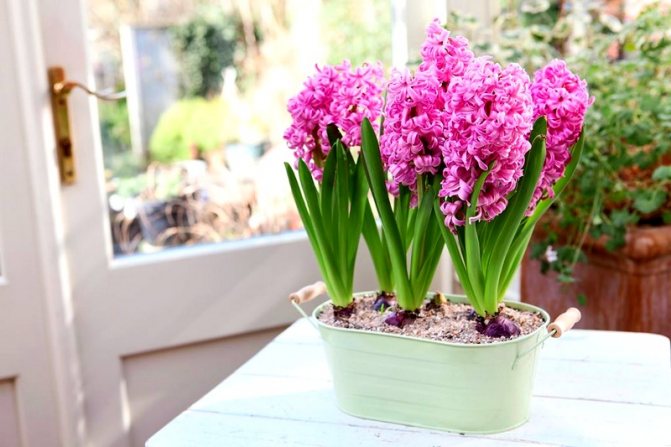

It is also worth noting some mistakes that beginner growers make during the forcing of hyacinths. For example, they can lead to improper watering, as a result of which the leaves of the plant turn yellow. This applies to both overflow and underflow. In addition, there may be a lack of light.
On a note! An error during watering can also explain the fact that the flower does not open the buds.
The point here is not only the volume of water poured onto the ground, but also when it hits the buds. Hyacinth takes protective measures, as a result of which the buds try to close so that moisture does not get inside.
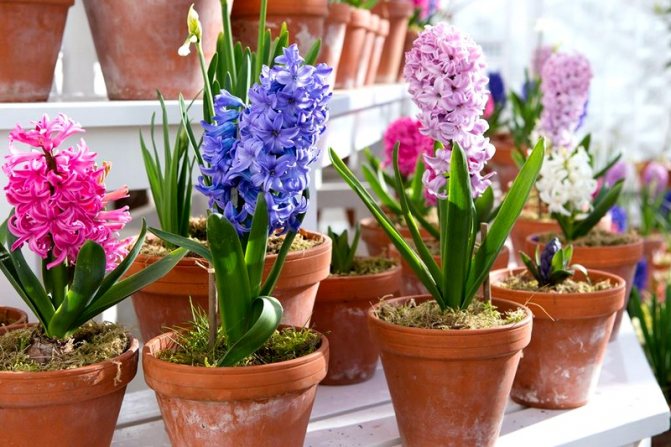

If the leaves of your flowers are growing extremely slowly, you most likely came across a defective bulb or you made a mistake with its storage.The same reason leads to the fact that the buds do not appear at all. In any case, for the first time, you need to rejoice even in the fact that at least one bud will bloom. Then you will be able to improve your skills and achieve one hundred percent of their disclosure.
Post-flowering care
After the end of flowering, the bulbs are not thrown away, but they are not stored in pots until the next flowering. They will most likely not bloom next year. They are usually stored in a cool, dark room until autumn and then planted in open ground. After 1-2 years, the plants are restored, then they can be used again for forcing at home. It is more difficult to preserve heat-loving species, but many varieties of hyacinths winter well under cover and after a year of normal wintering and normal spring flowering, they again give flowers at home.
Preparatory procedures and landing
Unfortunately, not all of our citizens can use greenhouses to grow the flowers we are describing, and for them the only way to get hyacinths by March 8 at home is to grow them in flower pots. To do this, first select a suitable pot, the size of which directly depends on how many plants you are going to grow in it.
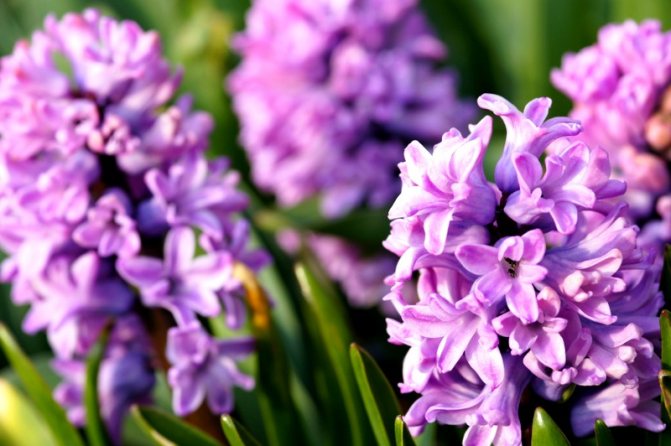

In any case, such a container should be at least 15 cm high. Drainage from a mixture of shards, pebbles and coarse sand must be laid on its bottom. It is necessary so that the water does not stagnate in the pot during watering. Otherwise, the bottom of the bulb will rot.
As for the question of when to plant hyacinths by March 8. In order for you to get a blossoming flower in March, you must plant the bulb in the ground in early November. If flowering begins earlier than your intended time, there is nothing to worry about, since it will last at least two to three weeks. At the same time, when deciding when to plant hyacinths by March 8, you must also take into account the plant variety. For example, early varieties can begin to bloom as early as 18-20 days after planting, while late varieties will take at least a month. If we call them specific types, then in Russia, among the early varieties of hyacinths, Lord Balfour, Anne Marie, Innosans are popular, and among the later ones - Grootvorst, Victoire, Madame Sophie.
How to achieve flowering for the holiday?
To make a plant bloom by a certain date, the easiest way is to count the time of its development by weeks. For example, "winter" for hyacinths lasts 10-12 weeks, then the period of peduncle formation before flowering begins another 3-4 weeks. This means that you need to start the forcing process 16 weeks before the due date.
Forcing bulbous plants is not difficult, but very interesting. To make you happy in the middle of winter with the first spring flowers, you just need to follow the correct technology and be patient.
What does it mean to "kick out" the bulbs? This means creating conditions for it under which it will bloom at an unusual time for itself. Daffodils, tulips, hyacinths and many others are among those flowers that can be successfully distilled in a greenhouse, in the open field, and in a pot at home. Let's talk about home forcing: now, when there is still snow outside the window, this is most relevant.
So, daffodil. Making it bloom in a pot is not difficult. For this purpose, you can use any variety, but nevertheless, small-flowered daffodils are optimal, which give whole bouquets of flowers in white, yellow or with a two-tone crown. You can buy daffodil bulbs in almost any flower shop, there are many offers on the Internet.
Large healthy bulbs are planted (a month before the expected flowering) in a pot at least 10 cm high - so that one third of their height is on the surface. The earth is crushed and watered. This should be followed by a dormant phase, when the seedlings are kept in complete darkness at a temperature of + 5-7 degrees in a cold basement, garage or on the lower shelf of the refrigerator. This stage ends with the emergence of sprouts.Now the plants need to be moved to a room with a temperature of +10 degrees to a well-lit place without direct sunlight. When the buds appear, it is advisable to increase the temperature again: up to + 18-20 degrees. Further caring for daffodils is reduced to timely watering and installation of a support at a high flower height.
After the daffodil has faded, you do not need to throw it away, but you just need to cut off the wilted flowers so that the energy of the plants is not wasted on the ripening of unnecessary seeds, but went to the development of the bulbs. Continuing to water and fertilize, you need to wait for the leaves to dry. Only then are the bulbs dug up, dried and stored. These bulbs are not suitable for distillation next year, but planted in the garden in the fall, they will take root and gain strength. Re-distillation is possible in a few years.
Forcing of hyacinths is the easiest at home. At the end of September - beginning of October, they are planted in decorative flowerpots, one or several pieces at a time, slightly covering the upper part of the bulb with earth. The pots are stored in a cold basement, and 10-15 days before the desired flowering, they are brought into a room with an air temperature (in the first couple of days) of 12-13 ° C. The soil is watered abundantly, the plants are covered with caps made of opaque paper for 7-10 days. This is done in order to slow down the growth of the leaves and stimulate the faster release of the flower arrow. At the end of forcing, the pots with bulbs are placed near a heat source to warm the soil to 22-24 ° C. Watering is carried out with warm water along the edge of the pot, so as not to soak the leaves and peduncle, otherwise the flower arrow may rot.
When flowering begins, the pot is moved away from the batteries, preferably on a window or in a bright, cold room with an air temperature of 8-12 ° C - this will increase the duration of flowering.
After the cessation of flowering, the life of the hyacinth does not end, the leaves develop. Therefore, the plant must be kept in bright light at 13-15 ° C, watered and fertilized weekly.
When the leaves develop and die off, the pots with bulbs are removed to the basement until July, then the tubers are dug out, peeled and dried. They are stored at a temperature of 25 ° C for two months, and at the end of September they are planted for growing in open ground. After two years, these bulbs can be reused in forcing.
Similarly (with some nuances), other bulbous plants are distilled. Having driven out several flower varieties at once, you can create an interesting composition by arranging pots next to each other. Such a blooming living corner on your windowsill will delight the eye with the colors of a cheerful summer, creating an oasis of warmth and light!
Applying distillation, you can independently get a beautiful bouquet of summer or autumn flowers for a winter or spring holiday. The whole process will take 2 to 4 weeks. Therefore, it is quite realistic to calculate the beginning of work in order to be in time for the scheduled date.
Forcing plants can be carried out without using soil. To do this, you only need a container with water, where a coal or a pinch of salt is added for disinfection. It is better to choose enamel, glass or ceramic dishes for distillation.
Forcing bulb flowers in water
It is convenient to use hyacinths, lilies and tulips as forcing objects. They bloom easily on nutrient solutions. Large onions are placed in vases or so in two-piece glasses with a removable cylinder having a bowl-shaped extension at the top. There should be a gap of 1.5-2 cm between the bottom of the bulb and the water. The water is changed carefully, trying not to soak the bulb. The bulbs are placed in water in October or early November. Keep for two months in a cool (less than 15 ° C), dark place. When the first sprouts 5-7 cm long appear, the containers are transferred to a room with a temperature of 15 ° C. When buds appear, the plants are brought into the room.After two to three weeks, the first roots appear, and two full months after the start of distillation, the root system should completely fill the vessel with water. Flower bulbs that have been distilled in a nutrient solution are no longer reused. Unfortunately, the plant will not be able to restore the supply of nutrients.
Forcing flowering woody plants
Lilac, bird cherry and other decorative tree species are suitable for forcing. The branches are harvested no earlier than December 10. You can cut them in October as well. The branches should be wrapped in paper and a plastic bag, and then put in a cold place for 5 weeks. Before being put into water, the twigs are kept in room conditions for some time. Then for 8-12 hours they are placed in water with a temperature of 30-35 ° C. Before that, it is better to gouge the ends of the cut branches with a hammer or cut them under water and split them in half. The vase is first kept in a dark place or a black cap is put on. When the kidneys are swollen, they are exposed to light. It is advisable to spray the branches periodically.
30 g of sugar, a pinch of chloramine or 0.03% silver nitrate are added to the water. You can also use citric acid. For faster flowering, add a few drops of ammonia. And as additional food, a 0.1% solution of potassium nitrate is used.
Leaving during forcing
Continuing the topic of humidity, we note that for distilling a plant, it is necessary to maintain the usual room temperature of about + 25 ... + 26 ° C and humidity in the range from 70 to 85%. To maintain these indicators, it is enough to put the pots with bulbs in a warm place in a tray filled with wet river sand.
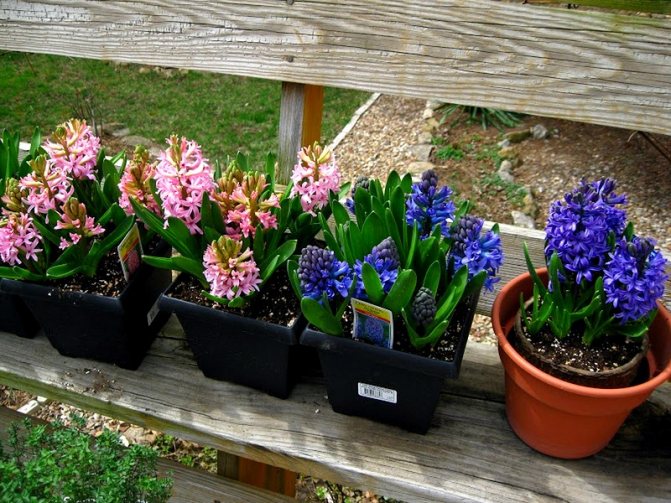

About ten to fourteen weeks after planting, the first green leaves should hatch from the ground. After they grow up to 4-6 cm, the pot must be moved to the windowsill, where the temperature is maintained at about 13 ° C. You need to put a paper cap on the pot for about 10 days. This is done in order to protect the plants from sunburn, and also to speed up the process of pulling out the sprouts.
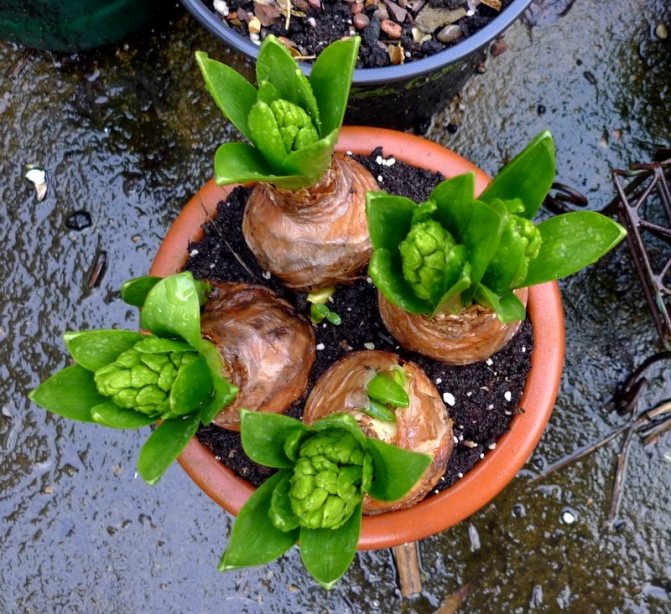

As a result of all the above procedures, our hyacinth will have to grow by about 15 cm. As for caring for it, during growth, you should try not to flood it in order to avoid death. By the way, after the leaves of your plant have opened and the peduncle is ready to bloom, it can be transferred to any lighted place in the apartment suitable for you.
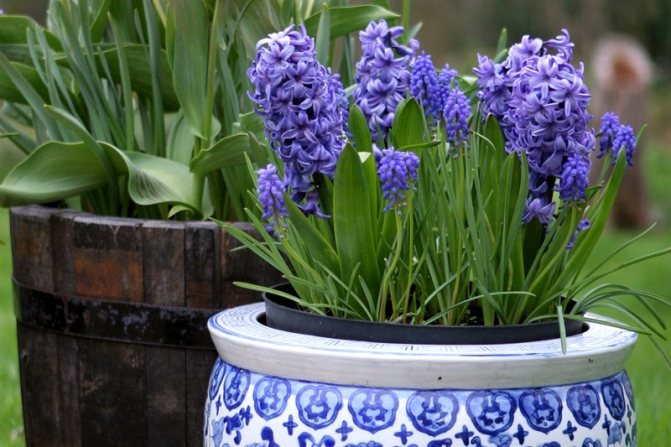

In order for its flowering to be long and successful, the following conditions must be observed:
- room temperature approximately 20 ° C;
- complete absence of drafts;
- lack of direct sunlight;
- finding a pot with a flower away from heating appliances.
It is possible to use the planting material to perform the forcing procedure several times. For this, the bulbs are removed from the soil after the end of the flowering period. Then they are transferred to a dark, cool place and stored in fabric bags until they are planted in the fall in open ground. In it, the bulbs will rest for 3 years, after which they can be put back into forcing.
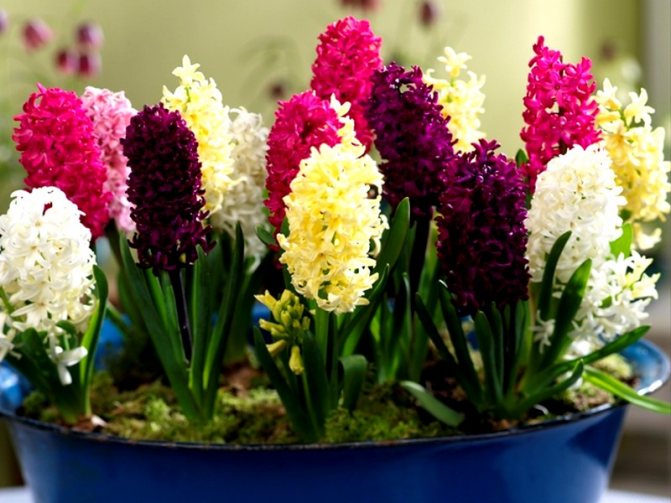

But in the case when you want to drive out the hyacinth in the water, the bulb will no longer be used for anything, since it will be too depleted. The very same procedure consists in placing the planting material in water poured into a vessel with a narrow neck so that the bulb can take root. At the same time, coal is added to it in order to avoid damage to the plant. For the entire duration of such a distillation, the hyacinth is placed in the refrigerator, and it is transplanted into the pot only when it grows up to 5 cm in height. Further, the entire growing season takes place on a cool windowsill.
Useful Tips
There are some tips to help you grow these wonderful flowers:
- before planting, without injuring, remove the black scales;
- we moisten the soil regularly, but make sure that it is not too damp or dry.
- we store the bulbs so as to comply with the temperature regime, for example, in the refrigerator;
- when we get out of the refrigerator, we check the bulbs a second time; to make it easier to define
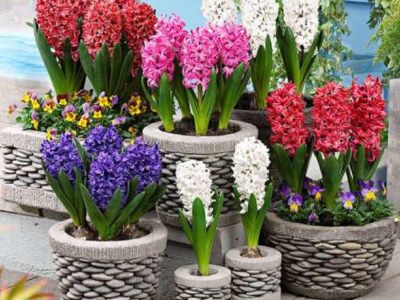

Photo: hyacinths in indoor conditions
Forcing hyacinths is an artificially created condition for a plant that usually blooms in the garden in summer or autumn. The rest period is also maintained as in natural conditions. A rested plant can begin flowering.
Cultivation recommendations
Bougainvillea cultivation and care at home
Growing hyacinths at home is not the same as in the country or in the garden. We must try to recreate the conditions as close to natural as possible.
It is not at all easy, but also not daunting to grow this plant. Any amateur can cope with this task.
How are hyacinths planting and caring for indoor conditions?
The requirements for caring for a hyacinth in a pot are as follows:
The soil. A special mixture is used (turf, sand, humus, leafy soil and peat - in equal proportions). The soil in the pot must be calcined (thermally treated) before use. Lighting and location. This plant is very fond of light. He needs it at least 15 - 16 hours a day. Therefore, the pots in which the hyacinths are planted are best placed on the windowsills of the southern or southeastern windows. If this is not possible, then you will have to provide additional artificial lighting. On hot sunny days, plants should be shaded or removed from windowsills to avoid sunburn. The hyacinth on the windowsill needs to be turned occasionally so that the flower is symmetrical. Temperature. Hyacinths are quite demanding on the air temperature in the room (+ 20 ... + 22 ° С). They hate drafts, sudden temperature fluctuations and the proximity of heating devices. You can imitate natural conditions by bringing the pots out to the balcony or loggia in warm weather. Watering and spraying
Watering is required extremely carefully and carefully. We exclude the complete drying out of the soil
Moisture is not allowed on the plant itself: it can rot. Watering is carried out by immersion in settled, not cold and soft water. There is no need to spray hyacinths in pots. In the process of flowering, moisturizing is generally strictly prohibited. Feeding hyacinths is carried out quite often. For this purpose, you can use any universal complex fertilizer intended for all indoor plants.
Landing dates
If you want to grow hyacinth in a greenhouse, you need to take into account some of the features of the flower:
- temperature regime;
- watering;
- light mode;
- top dressing.
The soil where hyacinths will grow and bloom should be nutritious and loose. Weeds and mice should not thrive in the greenhouse.
If the planting material was purchased in a package or in a specialized store, then they have already been treated with the necessary drugs to protect against diseases. Store them in a dark, well-ventilated place until planting.
Self-grown planting material can also be used, but only after it has undergone special training.
For distillation by March 8, the bulbs after digging are heated for two months at a temperature of + 25-30 degrees. After that, the temperature drops to + 17 ° C.
2.5-3 months before planting, the temperature is reduced to 8-10 degrees. Hyacinth is planted in an apartment for the holiday, taking into account the stages of development of the plant. This should be done around mid-October.
You can plant them a little earlier, in late September or early November. Growing at home lasts 4.5-5 months. The temperature is observed + 4-9 degrees, and from January 1 it must be reduced to +5 degrees.
For growing in a greenhouse, plastic boxes for storing vegetables are suitable. In it, you can drive out at once from fifty to 80 hyacinths. The substrate is prepared from a mixture of garden soil and sand in a 1: 1 ratio.
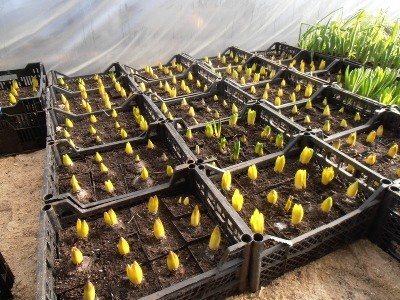

Photo: growing in a greenhouse
The sand must first be calcined to destroy all pathogenic bacteria. It is not recommended to apply nitrogen fertilizers, otherwise the plants will grow green mass, and flowering will slow down.
For better rooting, add 2 handfuls of superphosphate to a bucket of prepared mixture. And before flowering - any potash fertilizer.
The planted bulbs should be sprinkled with plenty of water with potassium permanganate (pink). Planting times in a greenhouse depend on the weather and are unlikely to be suitable for forcing on a particular holiday. The air temperature should be between + 4 ° C and + 9 ° C.
If there are a lot of boxes with plants, then they can be placed one on top of the other, and covered with an opaque cloth on top. When the bulbs begin to sprout, the material must be removed.
The soil should remain moist, watering should be done only when needed, about twice a week. To maintain high indoor humidity, the walls and floor are hosed.
Varieties of hyacinth
Zamioculcas home care, cultivation, reproduction and transplantation
Hyacinth is a member of the Asparagus genus and is a perennial bulbous flower. There are 3 types of it:
- Hyacinth Litvinov. With wide spreading leaves and a short peduncle. Flowers with pointed petals, the predominant tone is bluish blue. Can be perennial or annual. In the wild (in the eastern regions of Iran and Turkmenistan), it has been growing for more than one year, and in culture it is most often used as an annual.
- Transcaspian hyacinth. A small plant with narrow long leaves. There are usually more than two peduncles, the flowers themselves are blue and rather small. In the wild, hyacinth blooms in spring can be seen in the mountainous regions of Turkmenistan.
- The most common is, of course, oriental hyacinth. It is he who is defined as a typical type of culture, and on its basis new varieties and various hybrids are developed, of which there are already more than 300. Has a variety of colors.
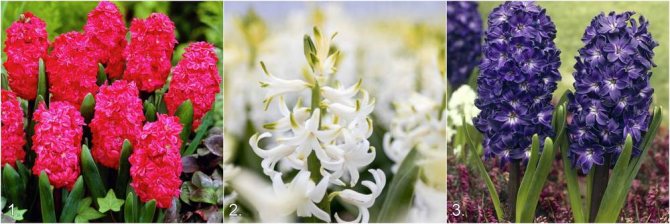

You can carry out a very conditional division of oriental hyacinth varieties by color:
- blue (Maria, Delftblue, Royal Navy);
- white (Ailos, Edelweiss, Argentina Arendsen, Carnegie);
- pink (Fondant, Jan Bose, Pink Pearl);
- red (Woodstock);
- yellow (Orange Bowen, Apricot passion, City of Harlem);
- purple (Amethyst, Bismarck, Menelik).
Hyacinth Mix is a double-flowered hybrid that can have very different colors. This is a flower mix.
Growing hyacinth at home
Rooting
The bulb takes approximately 2 months to take root (6-10 weeks). We start by planting the Hyacinths in a permanent pot. It should be small (if there is one flower), or wide and shallow (if there are several). In the latter case, the bulbs must be placed at a sufficient distance so that the flowering arrows do not interfere with each other.
The bulbs need to be deepened 2/3 of the height into the ground. Necessarily 1/3 of its part and the growth point must be above the ground surface.
For planting, I use a universal soil. It can be mixed with the flowering mixture - it is lighter and more acidic, which guarantees better flowering.
Germination
After planting, place the container with the bulbs in a dark, cool place. If the pot is small, you can put it in the tray of the refrigerator (I did just that). If you are planting multiple bulbs, place a container in your basement. Rooting conditions: absolute darkness at a temperature of + 5-7 ° C. Watering is very rare, but do not allow the soil to dry out completely.
Forcing arrows
Read about what colors can be grown on the balcony
The first shoots should appear in about 2 months. When the shoots reach a height of 3-5 cm and you see that the flower arrow has hatched, you need to pull the Hyacinths out into the light of day. But the temperature of its content should be about 12-15 degrees. It can be a glazed terrace or a closed balcony.
Now you need to extend the flower arrow. To do this, for a week I cover the flower with a paper cap made of thick dark cardboard with a tiny hole on top. The arrow begins to actively reach for the light source.
When it finally comes out of the socket, I remove the cap.
Bloom
After another 1-2 weeks, buds appear. After that, the flower can be brought into the house. Water the plant constantly, but do not water. At this time, Hyacinth can be fed with liquid fertilizer.
Even in the period when the buds appear, it would be nice to tie the arrow to a support stick so that it does not bend under the weight of flowers during flowering.
From time to time, you need to turn the home hyacinth towards the sunlight, one side or the other, so that the flowers bloom evenly along the entire arrow.
Blooming hyacinth at home can last 2-3 weeks.
Preparation of planting material
Bulbs with a diameter of 17/18, 18/19 are suitable for forcing, sometimes 19+ cm are on sale - this is the best option. Smaller bulbs - 16/17, 15/16 (usually packaged for sale), will also bloom, but they will not give a dense inflorescence sultan, but will get off with several flowers, resembling in appearance rather the Spanish scilla. But to obtain cut and such bulbs are used in industrial cultivation.
By forcing hyacinth to bloom at an unusual time for it, you must create conditions for it to go through all the stages of development that it passes in the open field.
Purchased bulbs have already received all the necessary training, so it is important to simply store them correctly before planting - in a well-ventilated place, in the dark, at +17 o C.
Own planting material can also be used by picking bulbs of specified sizes for forcing. But they require several stages of preliminary preparation.
For early forcing of hyacinths (in November-December, by the New Year), bulbs in central Russia are dug up early, from June 20 to July 5, and dried at elevated temperatures (+ 30 + 34 ° C) and humidity 70-80% for laying of flower buds. After 2 weeks, the temperature is lowered to + 25 + 26 ° C for 3 weeks. In the future, they are stored at a temperature of + 17 + 20 ° C in a well-ventilated room, laid out in boxes with a mesh bottom. The humidity of the air should not be very high, otherwise signs of penicillosis appear on the surface of the scales - not too dangerous, but undesirable fungal disease.
For forcing medium and late hyacinths (in January-February, by March 8, and until April), the bulbs are dug a week later, heated at a lower temperature, + 25 + 30 ° C, for 2 months, then stored until planting at +17 o C.
How to regulate the rate of peduncle development
If you understand that the hyacinth will not bloom by the date you specify, you can speed up the process by adjusting the temperature and lighting: the temperature is increased by 2-3 degrees, the daylight hours are increased to 12-16 hours. You can slow down the development of the inflorescence by reverse measures: reduce the daylight hours or move the flower to partial shade, while lowering the temperature in the room by a couple of degrees. In cool conditions, the flowering of hyacinth lasts up to two weeks, and if the peduncle is strongly stretched, it is tied to a peg stuck next to the bulb.
Forcing crocuses
Forcing crocuses by March 8
Forcing bulbs at home involves the use of large planting material for this procedure, in which a flower bud is already laid. With regard to crocuses specifically, large-flowered plant varieties should be chosen for distillation, since botanical varieties will look too weak. Dutch hybrids of spring flowering have proven themselves best in this quality: Zhanna d'Arc, Striped Beauty, Grand Leela, Pickwick, etc. To create a beautiful bouquet, several bulbs of the same size are planted in one container.
If you have crocuses in your garden, dig them up before early September. Both crocuses from the garden and store-bought crocus bulbs at this time of year have small sprouts, but this does not mean that they are ready for distillation. Forcing crocuses by March 8 begins with the preparation of the bulbs: before planting, keep them in the refrigerator or on a cool loggia, placing them in a paper bag. Planting takes place from mid-October to mid-November, depending on which variety you are growing.
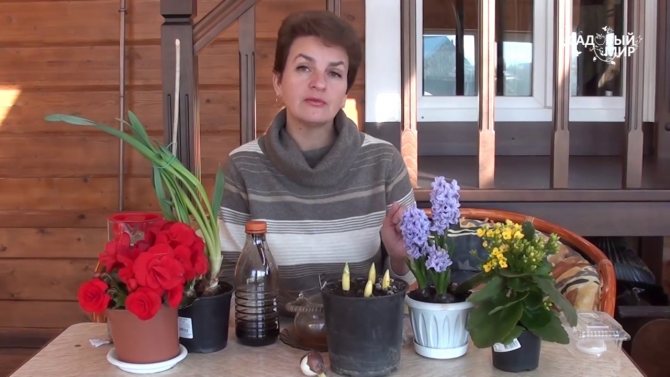

Forcing crocuses at home
For forcing crocuses, wide pots or bowls are suitable, in which you can plant 5-10 bulbs. A layer of expanded clay is placed on the bottom of the bowl, then a layer of substrate is poured, consisting of part of the sod and part of the leaf land with the addition of half a part of peat and sand. Crocus bulbs are placed in the pot with their bottoms down so that they do not come into contact with either the walls of the pot or with each other, completely cover the container with sand, watered abundantly and kept at a temperature of 5-9 ºC. It usually takes at least three months from the time the bulbs are laid in the cold until the forcing begins.
Forcing flowers is carried out in the presence of several signs:
- the height of the shoots should be at least 5 cm, and this applies to the weakest of the shoots;
- the readiness of seedlings for distillation is determined by their density - the seedlings should not feel empty to the touch;
- the roots should protrude from the drainage holes of the pot.
If these signs are present, you can move the bowl from the basement to a bright room with a temperature of about 15 ºC, but not higher, because the crocuses will quickly fade. As soon as the sprouts see the light, the crocus will begin to develop by leaps and bounds. To prevent flowering too quickly, expose the flower pot overnight in an unheated room with a temperature close to 0 ºC. If you follow this ritual, your crocus will bloom for about three weeks.
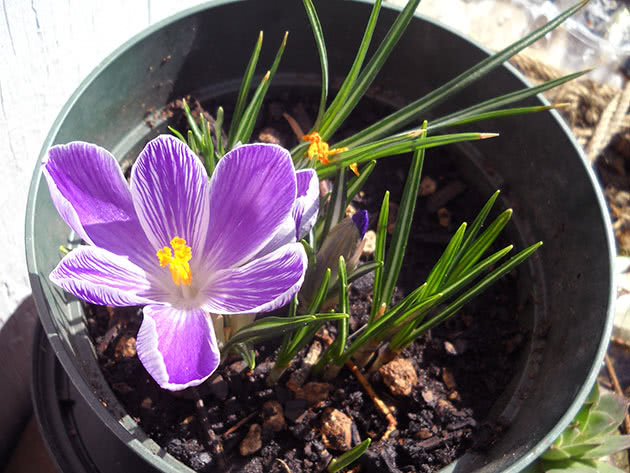

Planting material for forcing
Bulb selection
For distillation, it is better to take large, mature and dense bulbs that are not grown in a greenhouse, but in the open field. The bulb must be free of mechanical damage, signs of disease, traces of the presence of pests and have a decent weight. If you decide to buy hyacinth bulbs for distillation in a flower shop, then it is better to do it in September, and choose sizes 18/19, 17/18, or even better - 19+. Small bulbs will also give flowers, but their inflorescences will not be as dense and elegant.
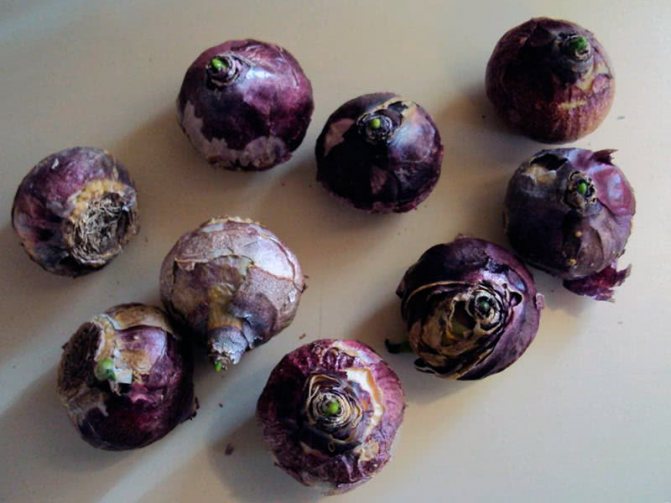

You can use your own planting material for forcing. It should be selected according to the same principle: preference is given to the largest, full-bodied bulbs without signs of damage and ill health. However, if the bulbs purchased in the store only need to be properly stored before planting, then your own bulbs require preliminary preparation, consisting of several stages, before forcing.
Almost all varieties of hyacinths are suitable for late forcing, and for early forcing, it is better to take bulbs of the following varieties:
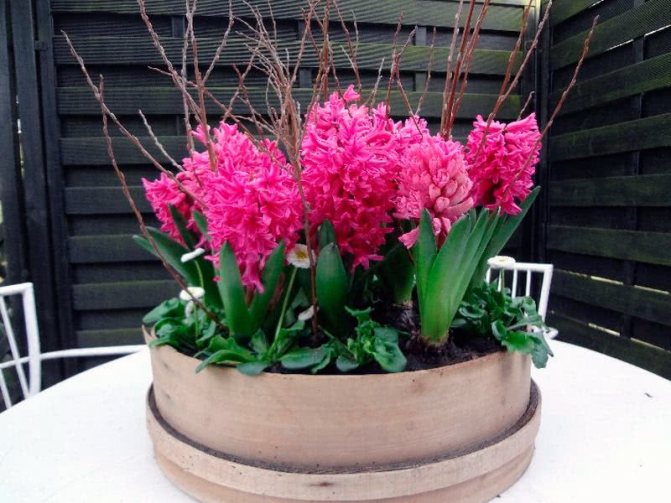

Storage of bulbs prior to planting for forcing
It is undesirable to plant hyacinths for distillation before September: after spring flowering, they need to have time to recover, otherwise the bulb will not give a good peduncle, the flowers will be small, and the inflorescences will be loose. Dig the bulbs out of the ground as soon as the hyacinth leaves turn yellow, fall and dry, but do not try to speed up the process by cutting off the wilting greens: the hyacinth leaves should fall off on their own.
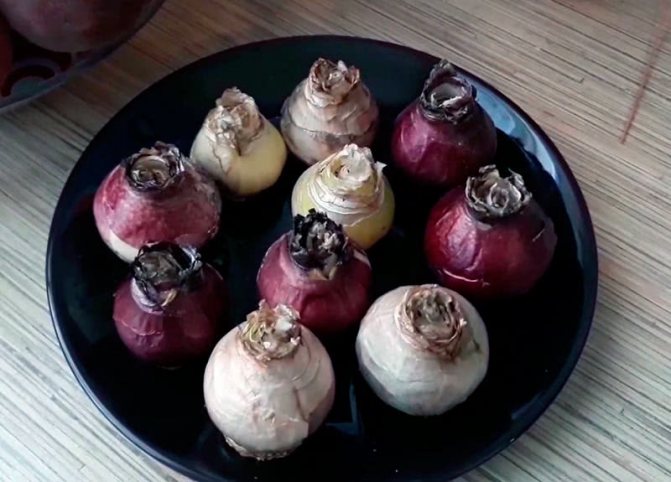

Let the bulb dry, peel it off and store for the first time at a temperature of 30-33 ºC in dry peat, protected from direct sunlight. At this temperature, flower buds are laid in the bulbs. After 2 weeks, the temperature is gradually lowered to 22-25 ºC and the bulbs are kept in such conditions for about 3 weeks, and about a month before planting, the temperature is lowered to 17-20 ºC. The room in which the planting material is stored should be regularly ventilated.In addition, the bulbs need to be revised from time to time in order to promptly remove spoiled, soft or pest-infested specimens.
If during storage some bulbs are slightly touched by mold, remove this plaque from them and lower the planting material for an hour in Fitosporin-M solution, and then dry well.
G? AC? NTY
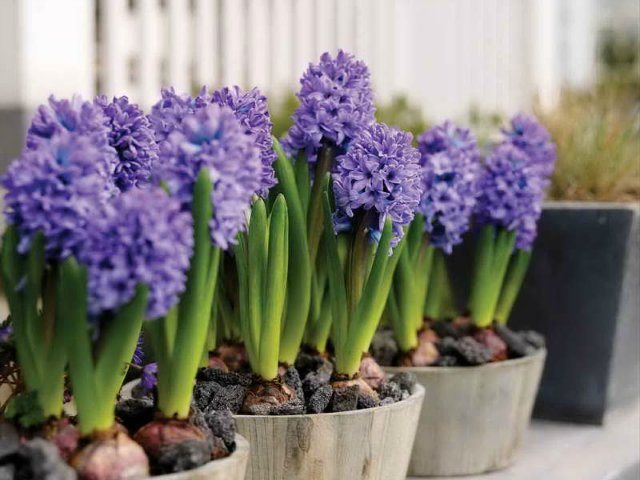

Hyacinth is good not only in a flower garden, bouquet, but also in winter forcing. For growing in an apartment, use pots, bowls or boxes. ? x fill with soil, consisting in equal amounts of river sand, turf and peat. If all these components are not available, you can get by with a mixture of river sand and garden soil, or even sand alone.
Before planting, the bulbs are stored in a dry, dark place at room temperature.
They are planted no earlier than November. Broken shards, gravel or expanded clay are placed at the bottom of the pot, then 1-2 cm of river sand is poured and filled almost to the brim with soil mixture, which is watered abundantly. The bulb is pressed into the ground with its bottom, sprinkled on top so that only its upper part is visible, and the ground around is pressed tightly. After planting, the top of the bulb is at the edge of the pot and 1.5 cm above the soil. The planted bulbs are covered with paper caps on top and placed in a shaded cool room for 40-45 days so that the plants form a well-developed root system. You can dig the pots into a greenhouse or trench by laying a film under them, and covering them with insulating material on top. or whether they are kept in the basement or even in the refrigerator. The main thing is that the temperature there is at the level of 6-9 ° C, since at a lower or higher level, root formation slows down.
The soil in the pot during this period must be kept moist.
In well-rooted bulbs, the roots are densely entwined with a clod and sprouts appear. As soon as they reach 8-10 cm, the plants are transferred to a warm room and gradually accustomed to light, removing the caps for several hours. Then they are removed completely and watering is increased.
During this period, it is important to observe the temperature regime. For 5-6 days, plants need a temperature of 17-18 ° C, and then it can be increased to 22 ° C. Moreover, by adjusting the temperature, you can control the duration of flowering yourself. So, at 10-12 ° C it can last 20-25 days, at 20-22 ° C only 15-18 days. Hyacinths usually begin to bloom three weeks after being brought into a warm room.
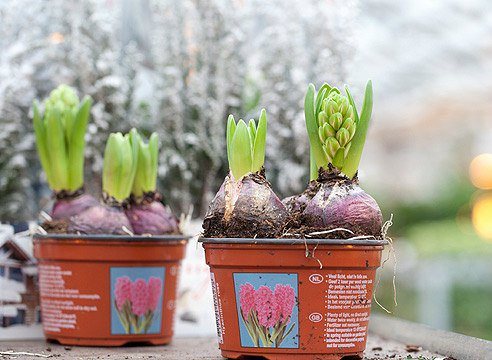

After distillation, the bulbs can be used for planting in the garden, but for this you need to replenish their strength. After flowering, you need to give them 2-3 fertilizing watering at weekly intervals. For top dressing, you need to take 1.5 parts of ammonium nitrate, 2 parts of superphosphate and 1 part of potassium salt (only 1.5-2 g / liter of water). The soil in pots is first watered abundantly with water, and then with diluted fertilizer.
When the leaves begin to turn yellow, watering is reduced, and with complete wilting, they completely stop.
After the leaves die off for a while, the bulbs are left in pots for ripening. Then they are taken out, cleaned and stored in a warm place, and in mid-October they are planted in the ground. For re-forcing, these bulbs are used only after two years of cultivation in the open field.
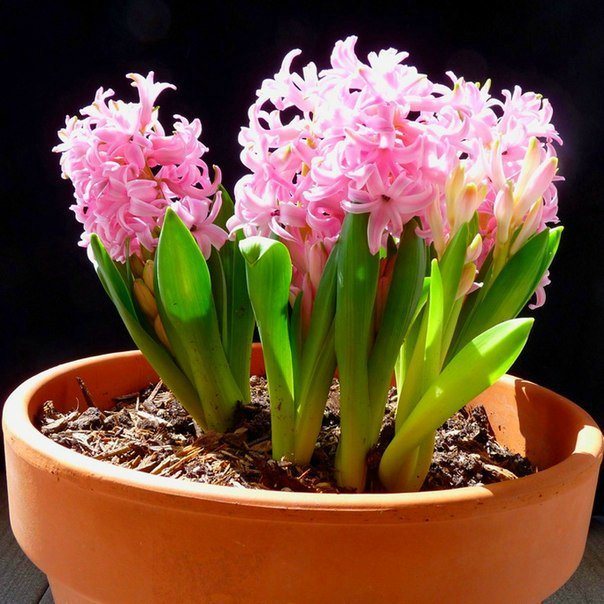

CARE OF G? AC? NTOM
Lighting Bright - during ripening. Shadow during rest.
Watering Regular in spring and winter, sharply limited during dormancy.
Air humidity No spraying.
Top dressing During flowering, mineral fertilizers. After flowering, phosphorus and potash.
Diseases and difficulties
Yellow leaves: the reason is drafts or improper watering and insufficient lighting.
The buds do not open: the reason is the ingress of water on the buds with careless watering.
Long lethargic leaves: The reason is the plant was kept in the dark for too long or insufficient light during the flowering period.
Slow growth: the reason is not a long dormant period: it is possible to transfer the plant to a bright room only when the sprouts reach 2.5-5 cm in height.Insufficient watering may be another reason.
Lack of colors: there are several reasons. Either not large enough bulbs planted for distillation, or keeping the bulbs at too high a temperature, or too hasty transfer to bright sun or flowering can inhibit insufficient watering.
Deformed flowers: the reason is too high a temperature during the dormant period, if it exceeds 4-5 ° C.
Decaying flowers: the reason is waterlogging.
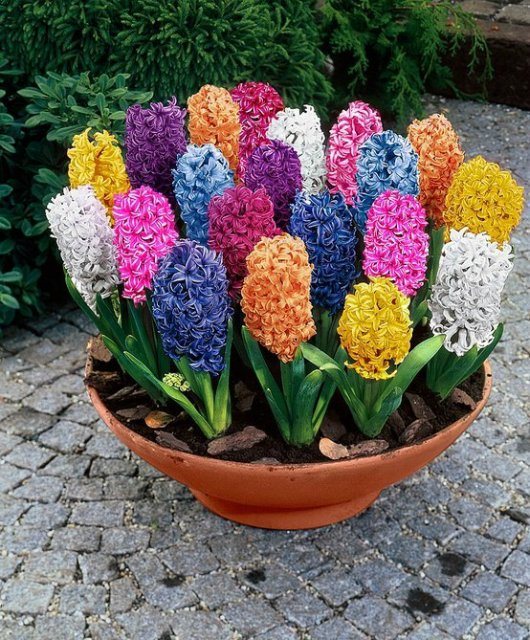

The best varieties of hyacinths for forcing
Not all hyacinth varieties are suitable for home distillation. Of the three plant species, only Eastern hyacinth can be used for these purposes. Depending on the variety, the color of the inflorescences can be pink, white, yellow, orange, lilac, blue. Forcing hyacinths by March 8 is considered late, earlier flowers are received for the New Year and Valentine's Day. Of the varieties of late forcing, the following are popular:
- Anna Lisa is a Dutch variety with lilac flowers, suitable for cutting;
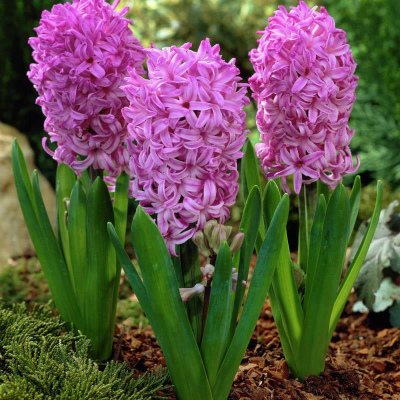

Hyacinth Anna Lisa - Madame Haubenzak - double flowers of a pale pink color bloom on the peduncle;
- Snow Crystal - terry variety, winner of international exhibitions, snow-white inflorescence, powerful;
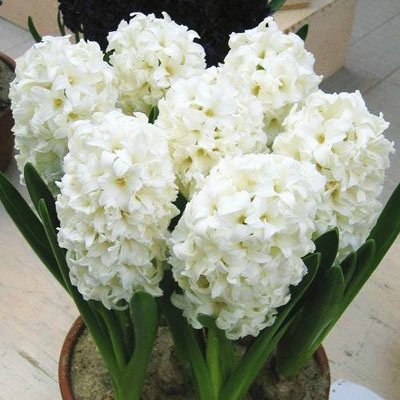

Hyacinth Snow Crystal - Hollyhock - a plant bred in Holland, with red fragrant flowers, suitable for cutting;
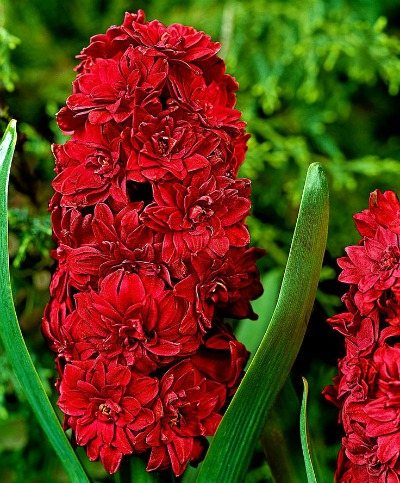

Hyacinth Hollyhock - City of Haarlem - the height of the peduncle with the inflorescence is up to 30 cm, the flowers are creamy yellow;
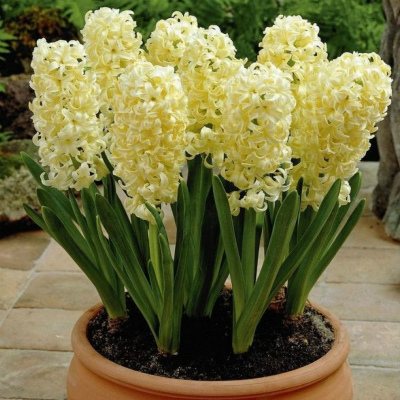

Hyacinth City of Haarlem - Woodstock - a variety with an unusual amethyst color and velvety texture of the petals;
- Gertrude is a plant with dark pink petals and a dense flower race.
Whichever variety you choose for yourself, you will not be disappointed. Almost all hyacinths have a pleasant rich scent and bright petals. The main thing is not to be mistaken with the planting date in order to get flowering specimens on time.
How to choose a bulb for planting
Hyacinth belongs to the asparagus family and has a rich palette of colors in all shades and a delicate aroma.
Now the fashion for these flowers has resumed and in March they fill the counters of flower shops. By this time, they are fully blooming or just filling the bud.
To independently engage in forcing for a gift for mom, you need to follow the technology of planting and caring for the plant. But first you need to choose the planting material.
In this case, you need to pay attention to:
- The size. The diameter of the onions is 4 to 6 cm. Bulbs that are too small or large should not be purchased. Please note: double and yellow hyacinths have small bulbs. Too large are also not needed for planting.
- They should be tight to the touch. Soft ones won't do.
- Externally, the bulbs should not have mechanical damage, manifestations of disease, as well as rot, mold and pest damage.
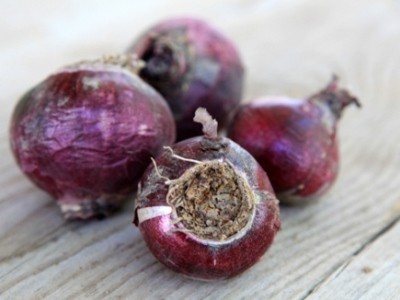

Photo: bulbs should not have mechanical damage, manifestations of disease
With proper care, hyacinth can bloom even for 10 years. In any case, you can count on 5-7 years of flowering.
The bulb is not renewed, so the older it is, the darker it is. Since they use the same planting material from year to year, you need to handle it carefully.
Answers to frequently asked questions
It would seem that the process of forcing hyacinths is not difficult, but those who do it for the first time sometimes encounter certain difficulties. Knowing about possible mistakes, growers will be able to avoid them or try to fix them.
Why does hyacinth not bloom, but only leaves?
If a hyacinth bulb purchased for distillation refuses to bloom despite proper care, there may be several reasons. Perhaps the onion is too small and simply lacks the strength to bloom.
In this case, the bulb is planted in the garden for growing, where it will bloom next year. Another reason lies in the wrong conditions of detention - most likely the flower was kept at too high a temperature.Lack of flowering can also be due to insufficient watering.
What to do if the hyacinth has a short peduncle?
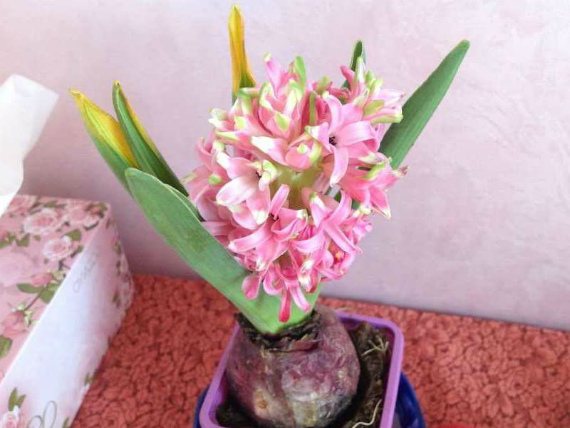

The appearance of a short peduncle can ruin the whole impression of a blooming hyacinth. Sometimes the inflorescences are practically invisible due to the foliage, the buds bloom in the center of the leaf rosette. The most common cause of inadequate flowering is a too short dormant period. The bulb should stay at low temperatures for about 3 months.
Poor watering and a sharp change in keeping conditions can also lead to the appearance of a short peduncle, when the flower, waking up, immediately gets into heat and is contained with a large amount of light. Until the peduncle reaches a length of 10 cm, the hyacinth pot is kept in a semi-dark cool place.
Hyacinth leaves yellow tips
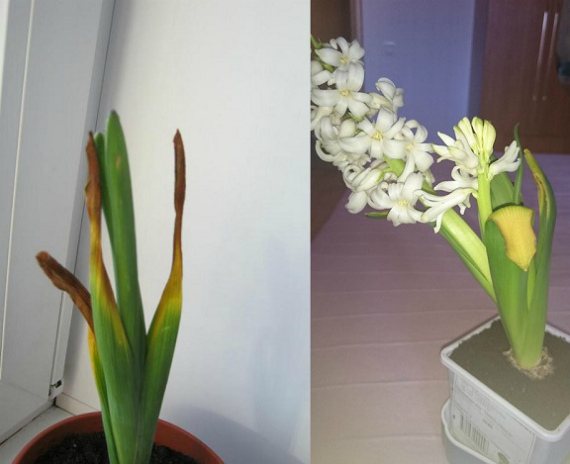

The reasons that the leaves do not gain a bright color lie in erroneous watering and a lack of lighting. Hyacinth belongs to bulbous crops, it should be moistened moderately after the topsoil dries out.
Sometimes the leaves can turn yellow after frostbite if the plant is placed in a draft. The injured leaves cannot be saved, they need to be cut off, and the pot with the onion must be rearranged to a warmer place. The peduncle will receive all the nutrients from the bulb.
Why is hyacinth called a rain flower
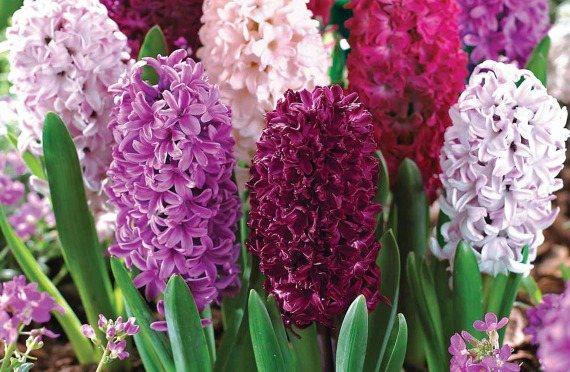

Hyacinth was called the flower of rain for the first time in Greece. This is due to Greek mythology, which says that an attractive young man named Hyacinth was injured during a sports competition with Apollo and was fatally wounded while throwing a discus.
The Greek god was saddened by the death of the Spartan and turned the drops of his blood into beautiful flowers, which people began to call hyacinths. After that, in ancient Greece, the plant became a symbol of the reviving nature. Later, the legend spread to other countries, where a whole sea of hyacinths bloom in the fields after the spring rains.
Content
- 1. Technology for forcing bulbous plants
- 2. How to grow tulips at home by March 8
- 2.1. Heat treatment of the bulbs after digging
- 2.2. Planting tulip bulbs for distillation
- 2.3. Tulip varieties for distillation by a specific date
- 3. How to drive out daffodils for the holiday
- 3.1. Preparing for forcing a daffodil bulb
- 3.2. Time and features of planting daffodil bulbs
- 4. Features of forcing hyacinths and crocuses
- 4.1. Agrotechnical material
- 4.2. Rules for planting hyacinth and crocus bulbs in the ground
- 4.3. Forcing crocuses and hyacinths in the water
Nothing will please or touch a woman dear to you - wife, mother, sister - like fresh flowers grown with your own hands. What flowers can be grown by March 8 at home? Almost any bulbous: tulips, crocuses, daffodils, hyacinths and more.
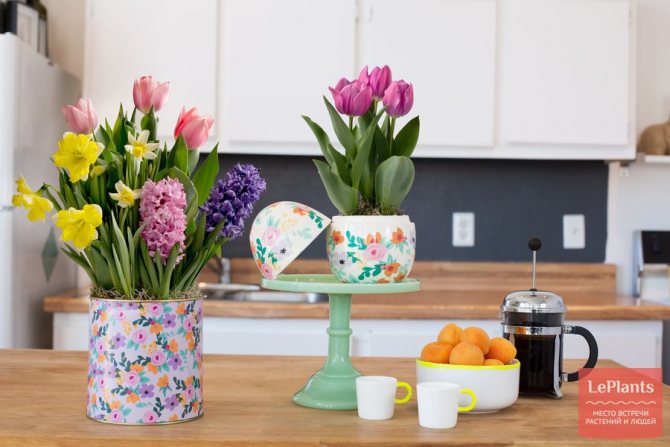

ON THE PICTURE:The bright colors of flowering bulbous plants will cheer you up even on the coldest days.
Forcing lilies
When to plant lilies for distillation
Low-growing varieties of golden, long-flowered, Japanese, tiger, Taiwanese, Philippine, snow-white, regala, etc. lilies are suitable for forcing at home. As in the case of other bulbs, the planting material must be flawless: large, dense, healthy bulbs, treated before planting for half an hour with a solution of potassium permanganate of medium strength. Another condition is age - bulbs must not be younger than three years old.
On average, the time interval from planting the bulb in the ground to the beginning of flowering lasts 3-4 months, or more precisely, for Asian hybrids it is 55-70 days, for oriental and tubular ones 3-4.5 months, for long-flowered lilies - 6-8 months from the moment the shoots appear, and the flowering of the tiger lily begins after the emergence of shoots in just 1.5-2.5 months. For early forcing, the bulbs are planted in the ground in October-November, for late forcing, in February or March.
- Hymenokallis at home: care and photos
Proper care and planting of lilies in the garden
Forcing lilies at home
The container for lilies should be deep and wide - at least 15 cm in diameter. A drainage layer is placed at the bottom of the pot, then a few centimeters of a substrate consisting of equal parts of sod, humus, leafy earth and sand, an onion is placed on the substrate layer, which is covered with the same substrate, immersed to a depth of 5 cm.After planting, the bulb is watered, on a layer of wet sphagnum is laid on the surface of the substrate and the pot is placed in a bright place with a temperature of 8-10 ºC - a window sill in an unheated room is most suitable for this.
Planting care consists in periodically moistening the soil. From the moment the sprout emerges, the temperature is gradually increased, eventually bringing it up to 20-25 ºC. Lighting should also be maximum, but without direct sunlight. Watering gradually becomes more frequent, and then more abundant, the developed leaves need to be sprayed. The temperature of the water for irrigation and spraying of lilies should be at least room temperature.
After the leaves appear, the lily needs to be fed every ten days with mineral and organic fertilizers of a weak consistency. When flowering comes to an end, spraying the leaves and feeding is stopped, and watering is gradually reduced until it stops completely.
